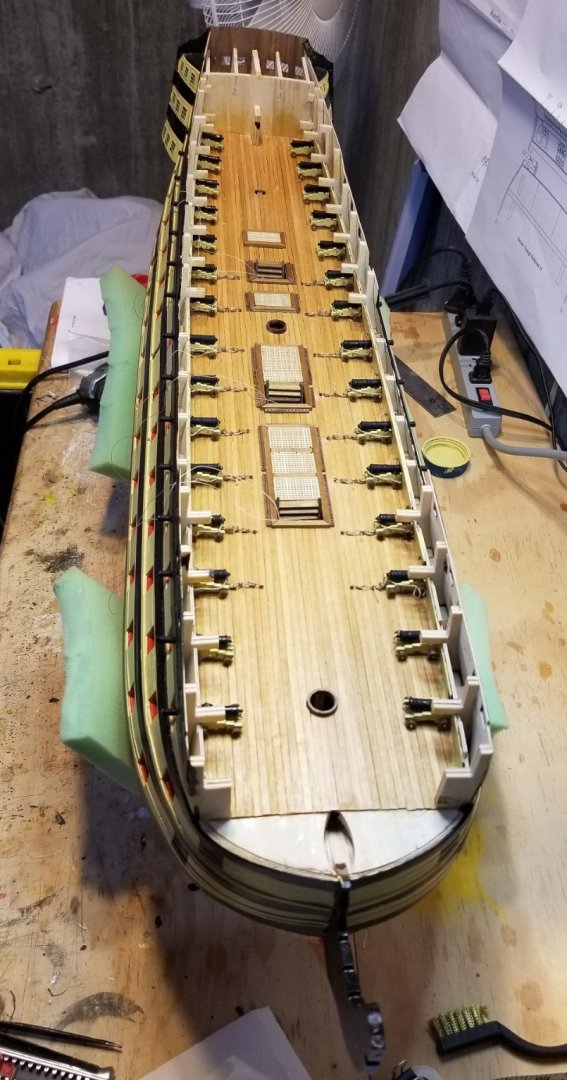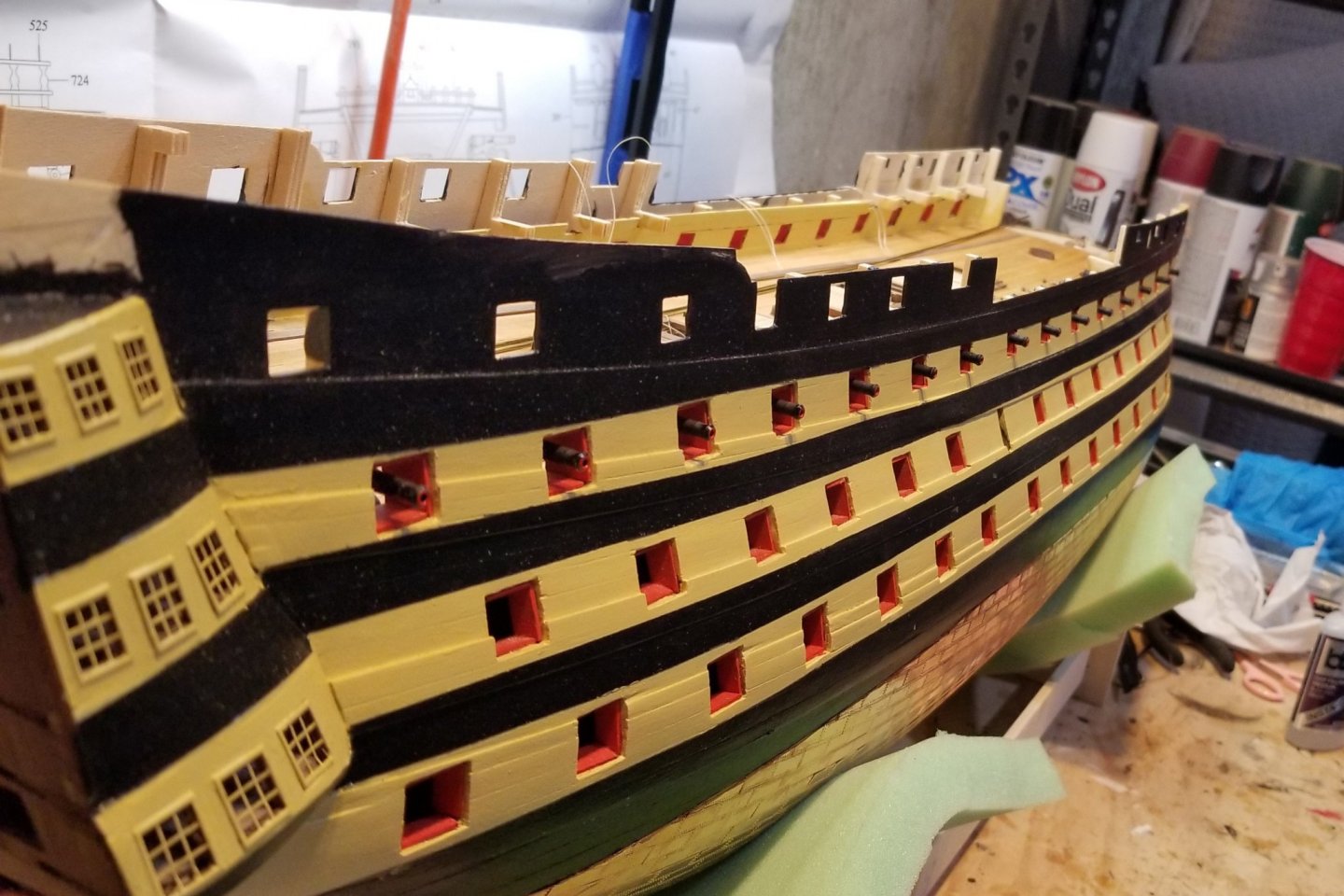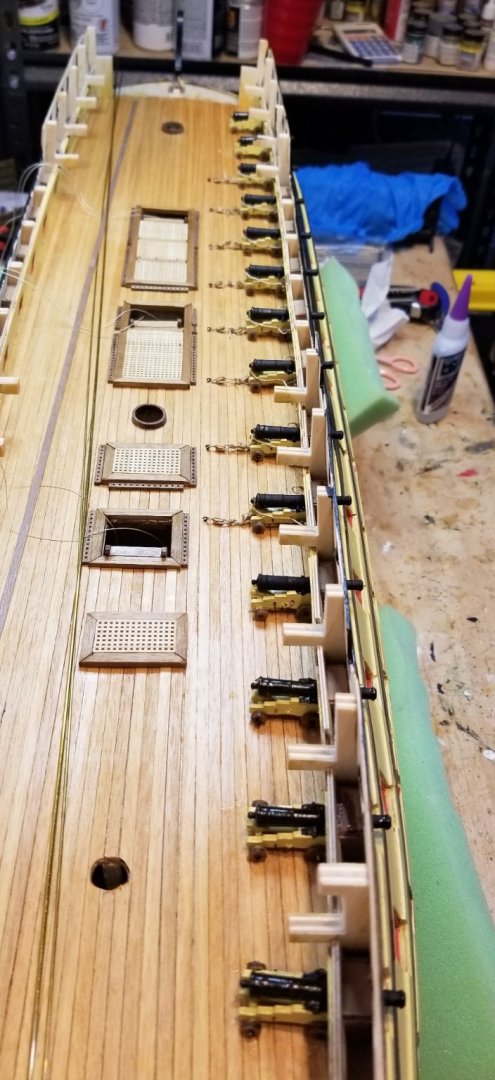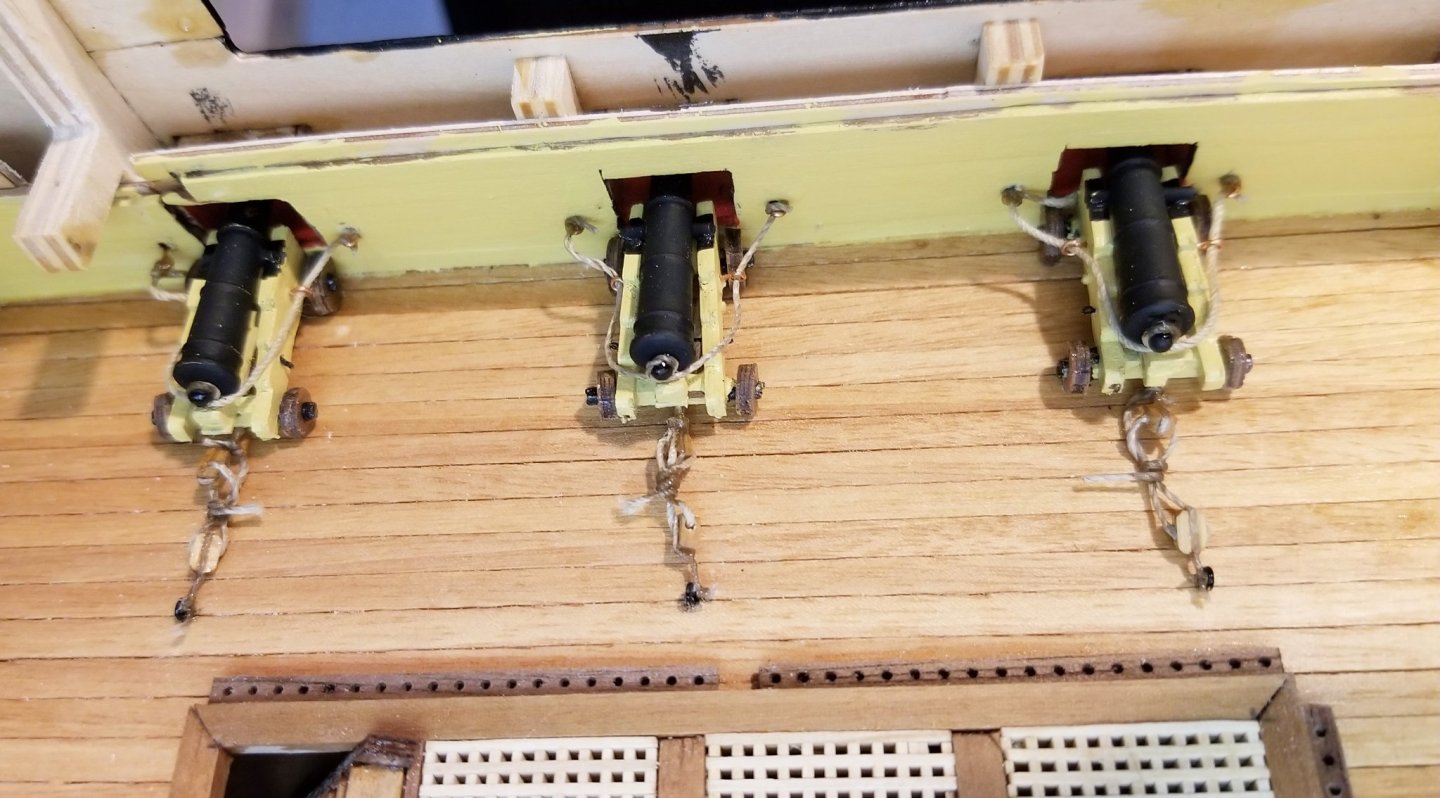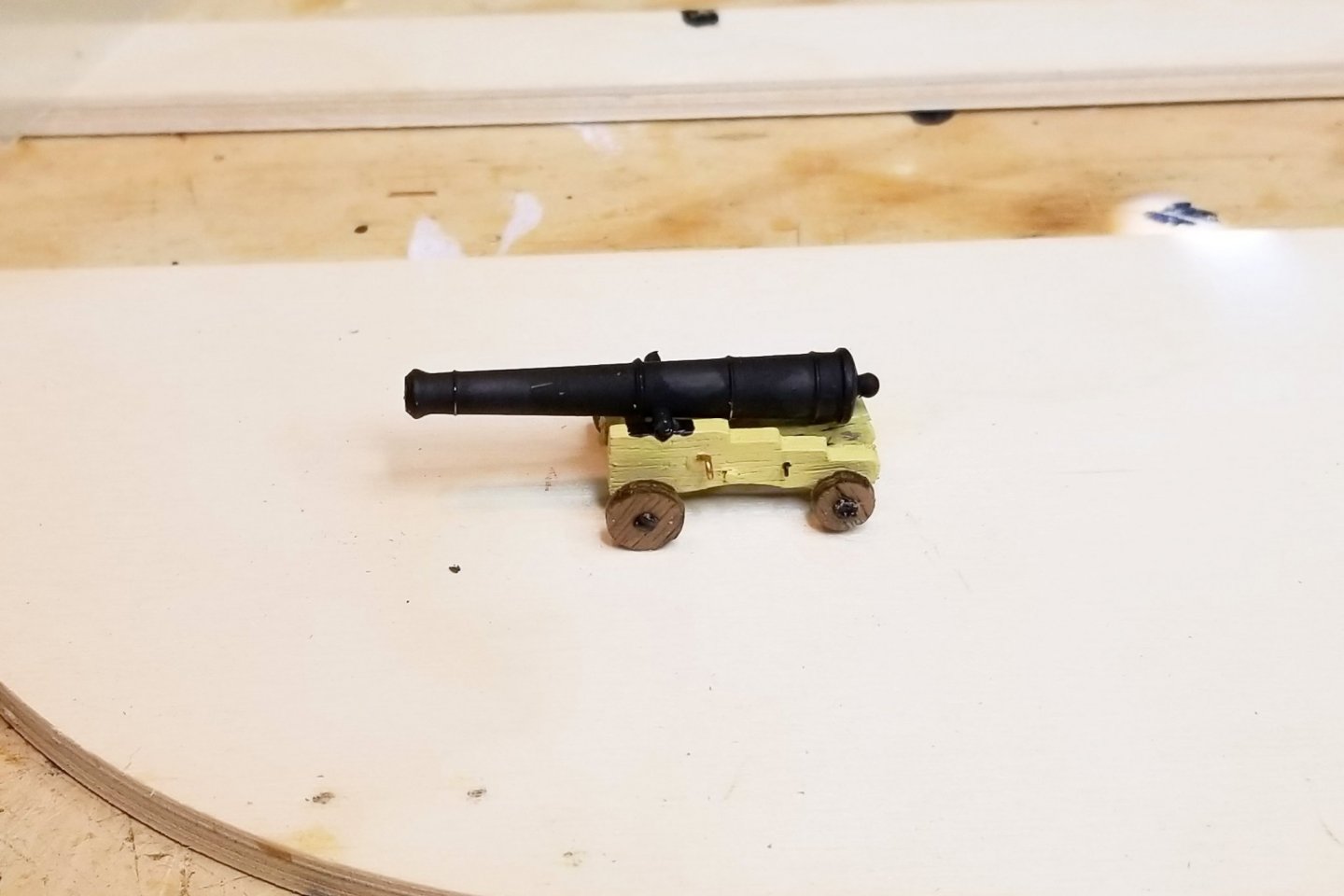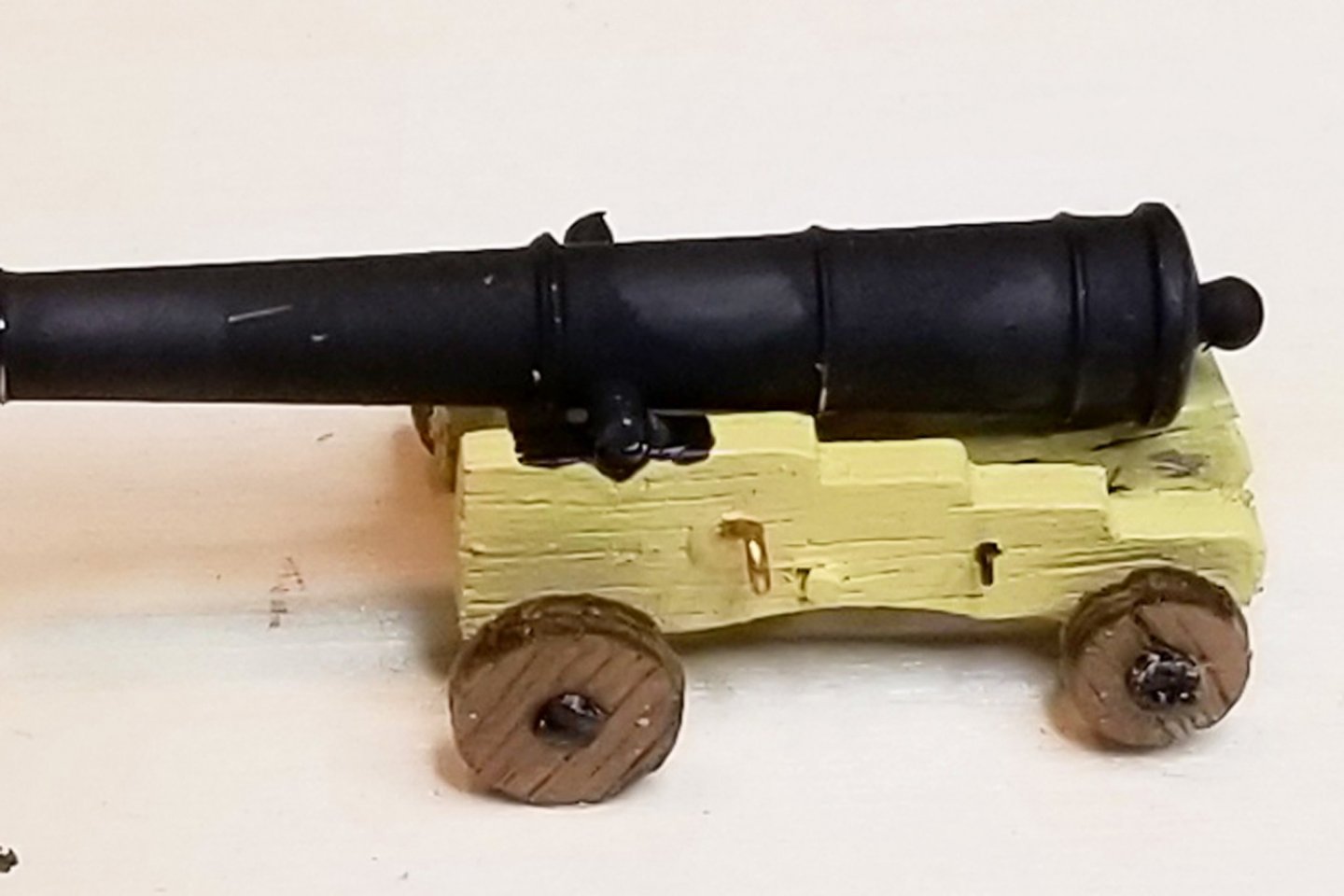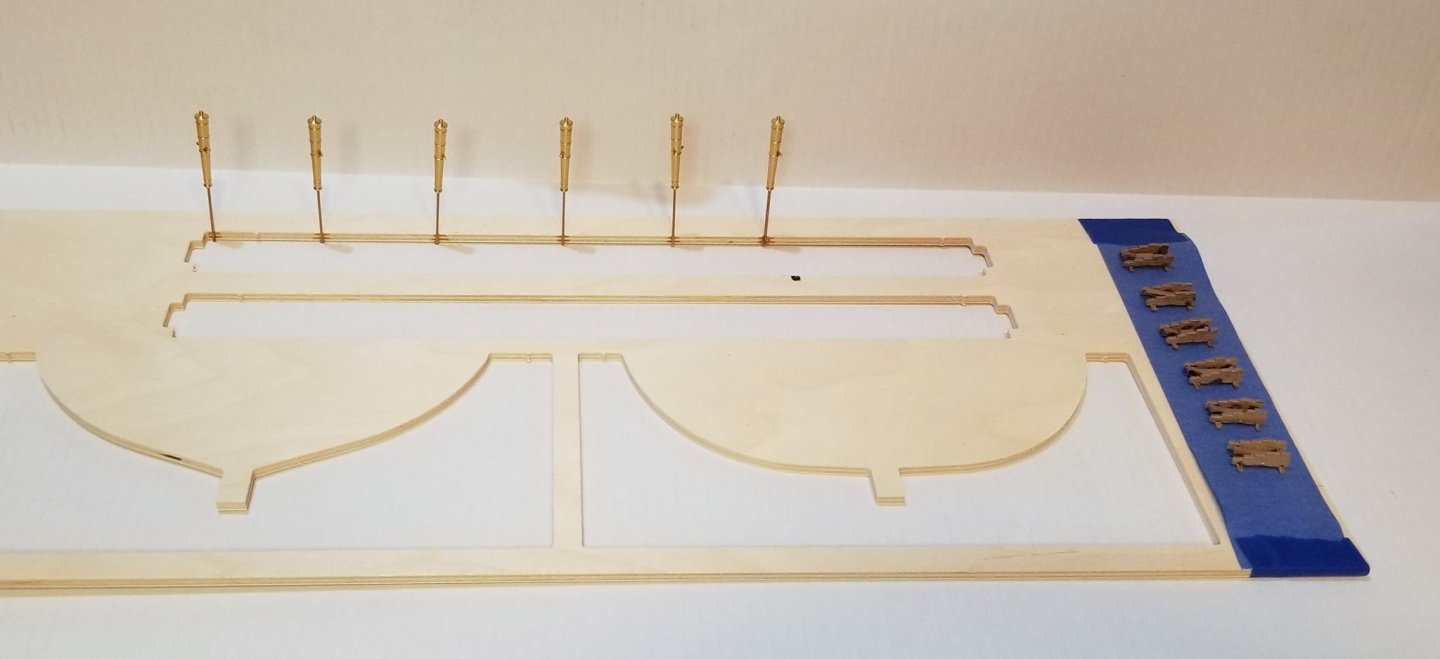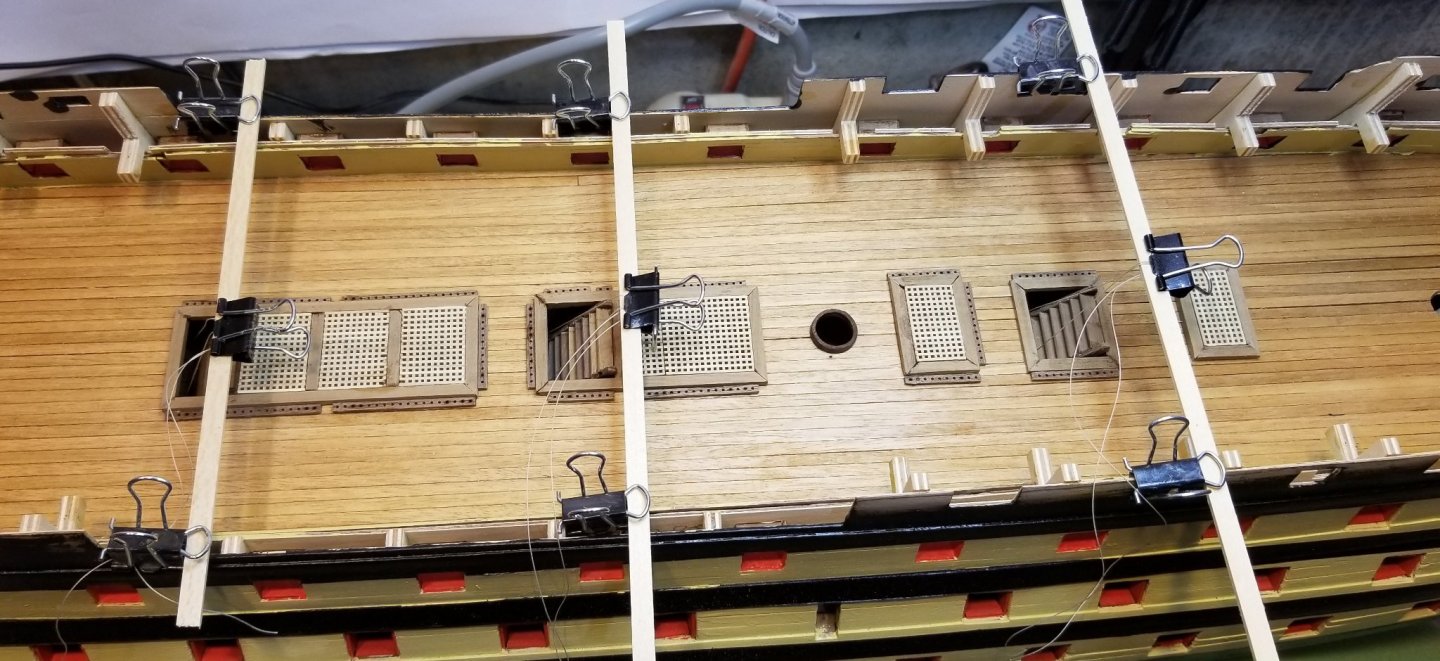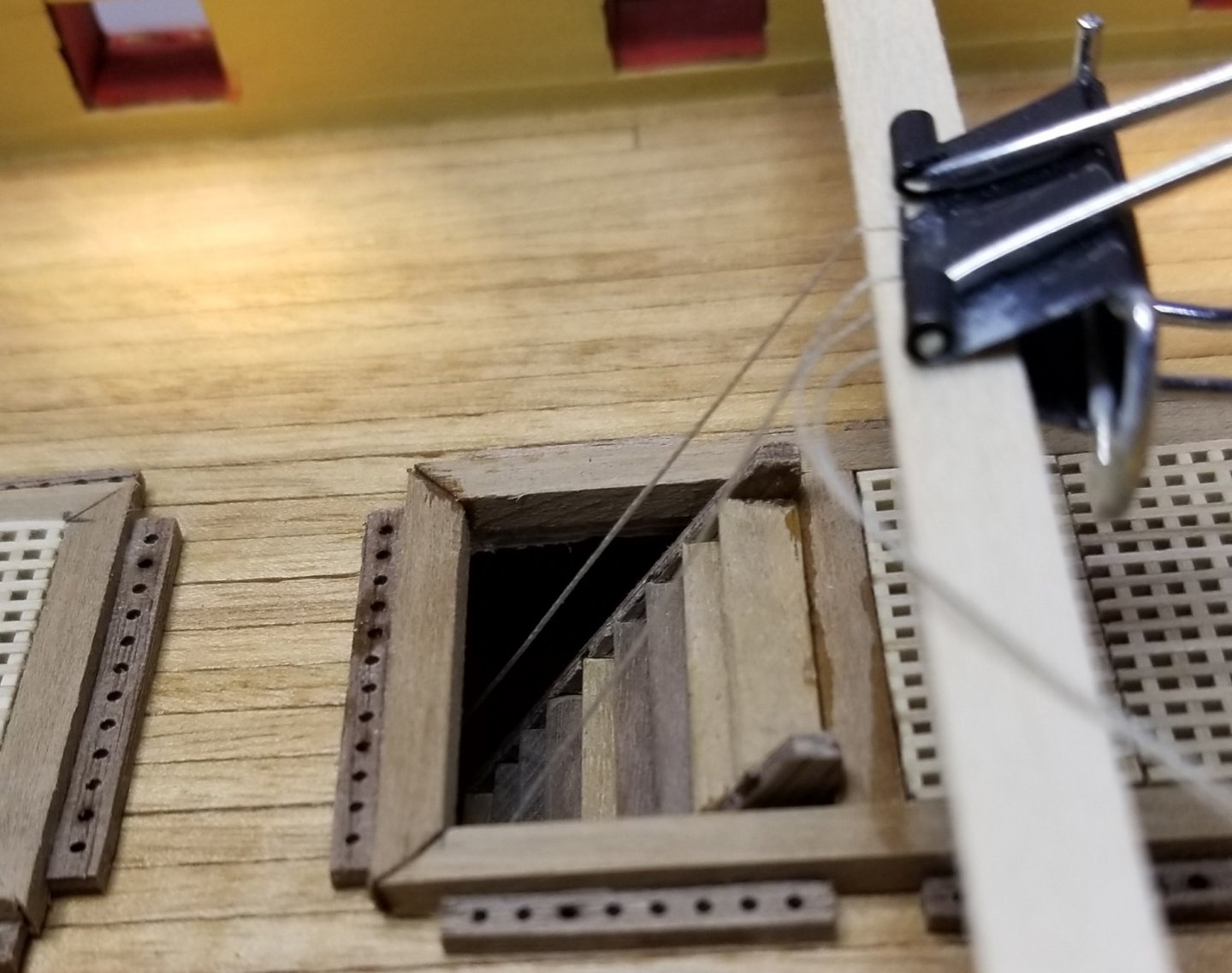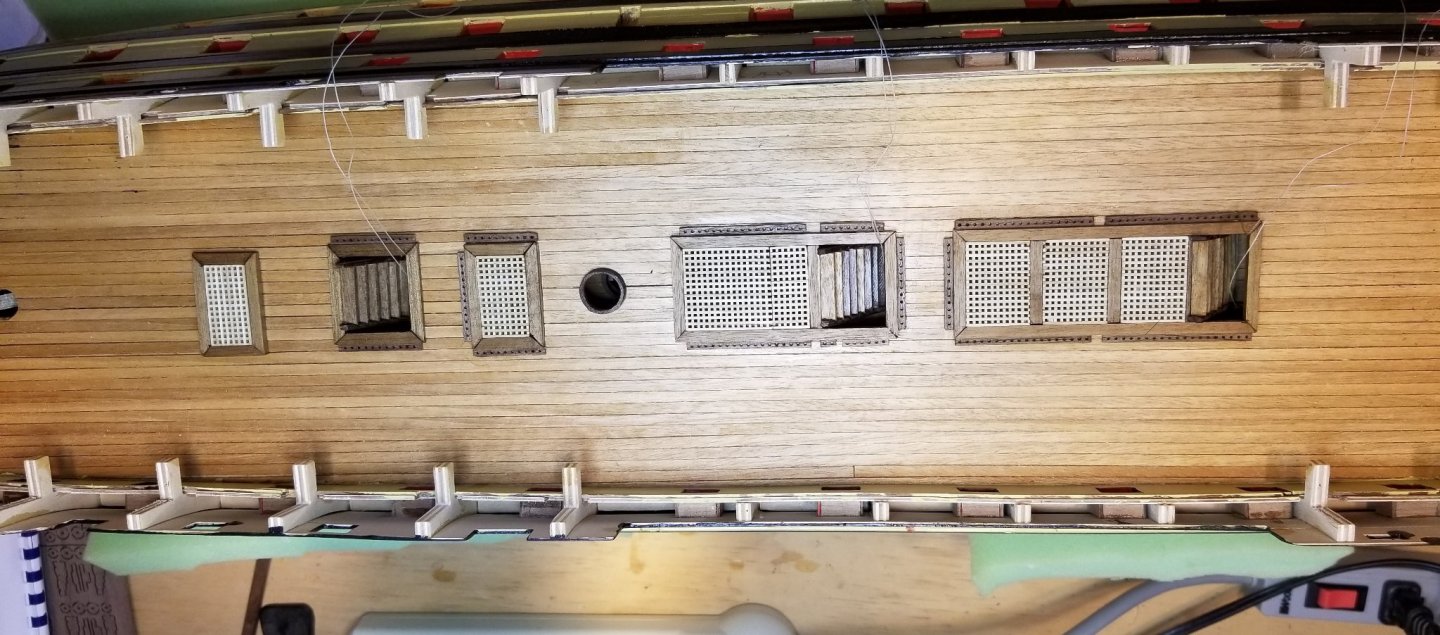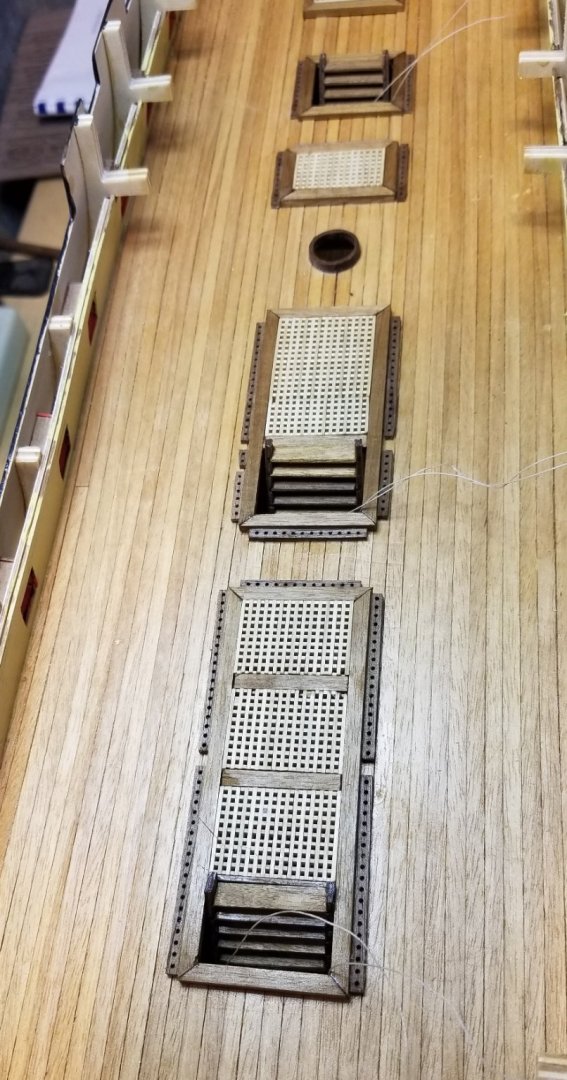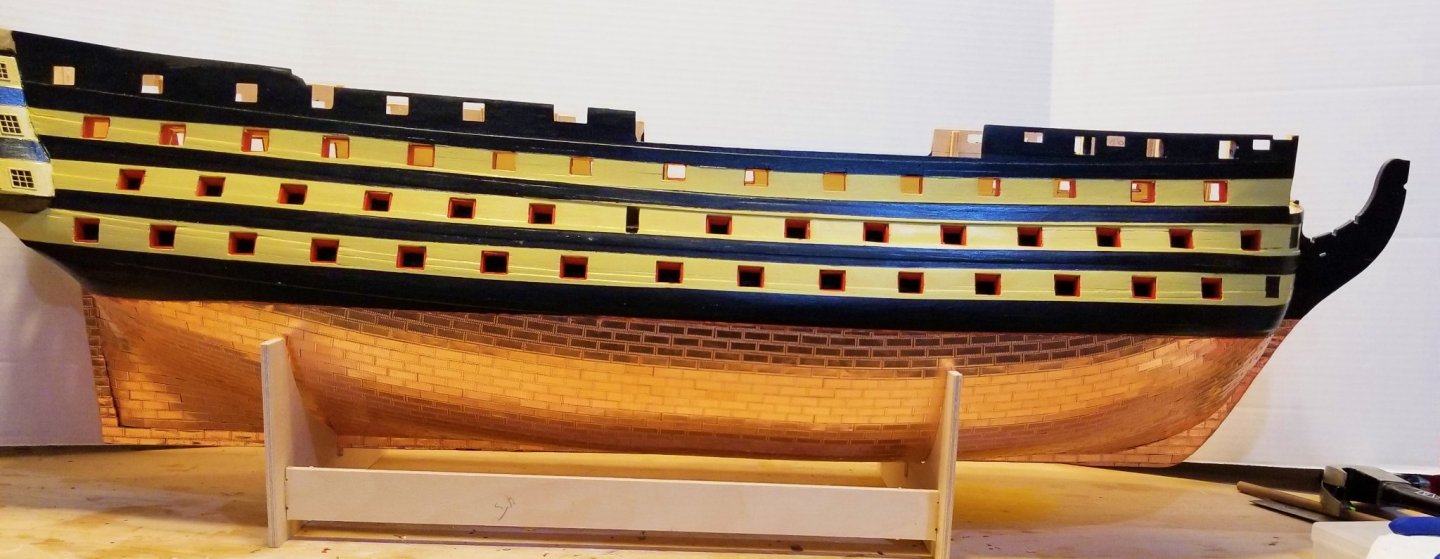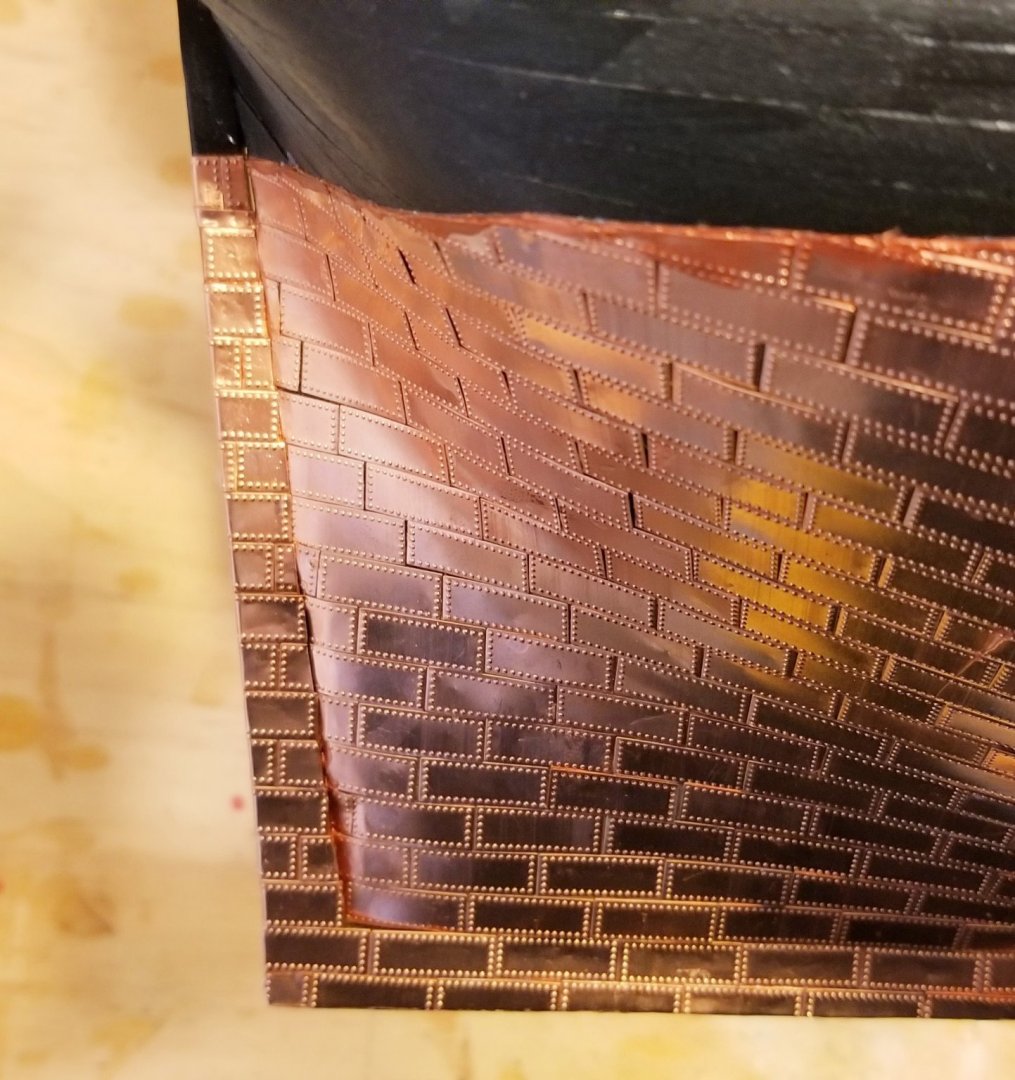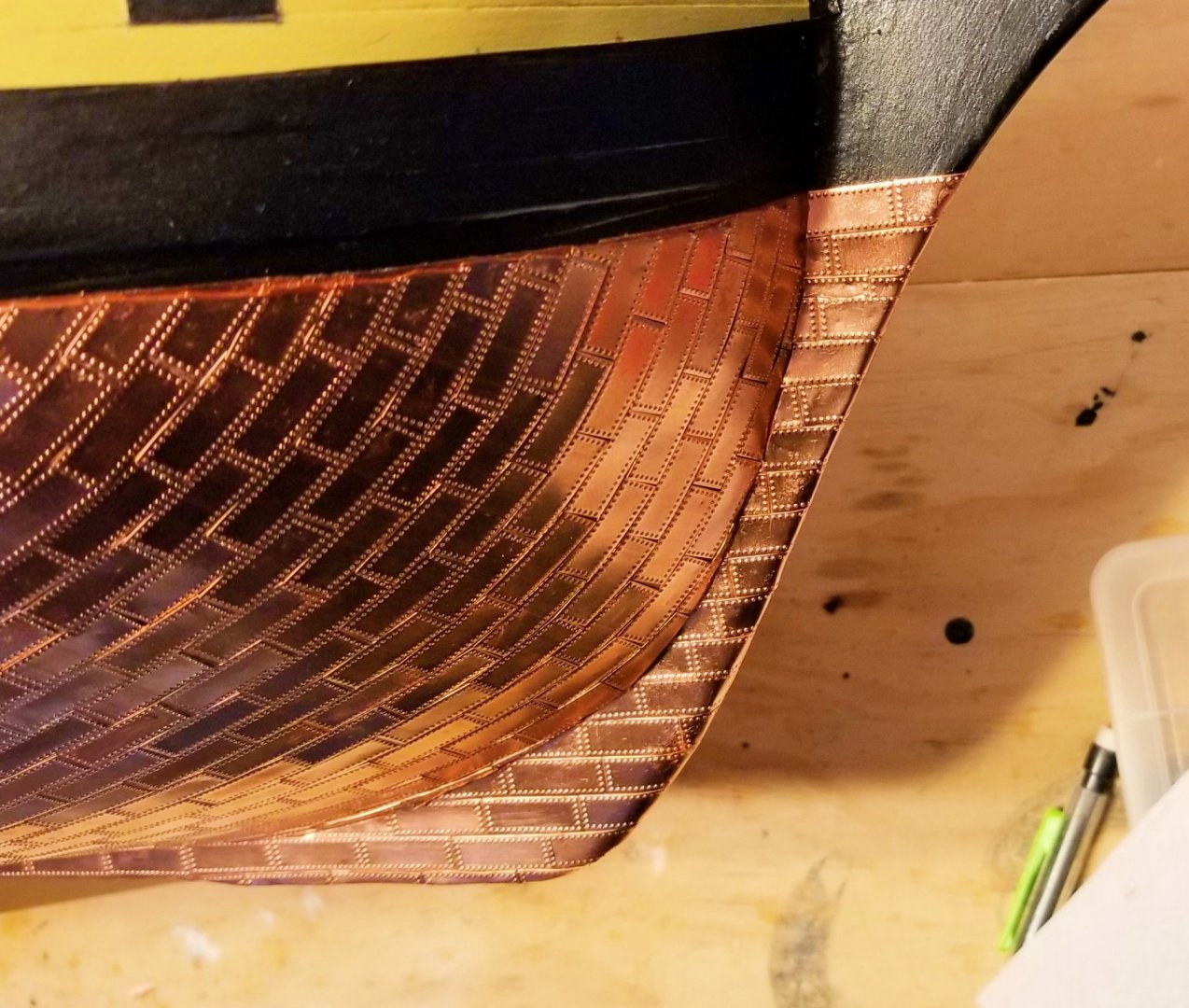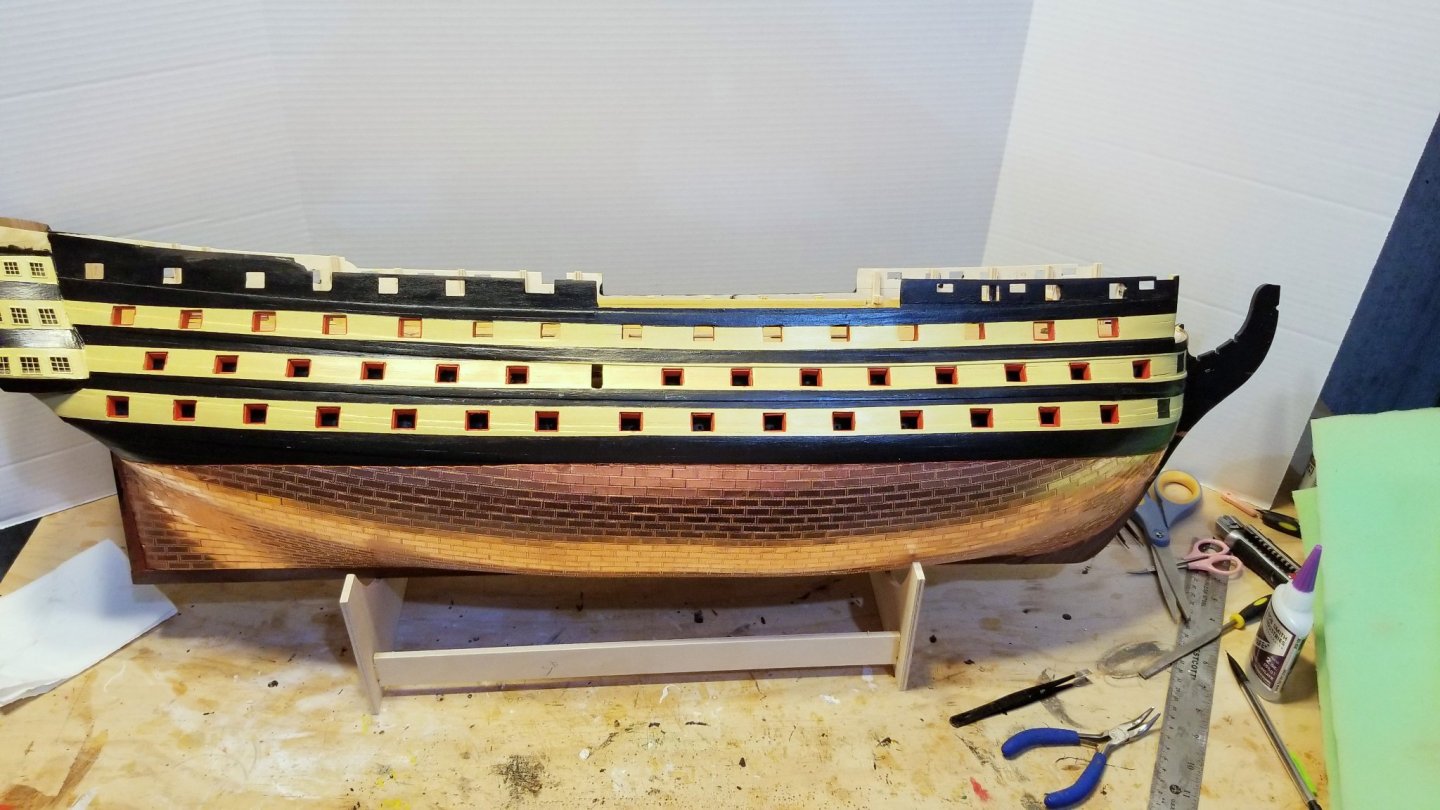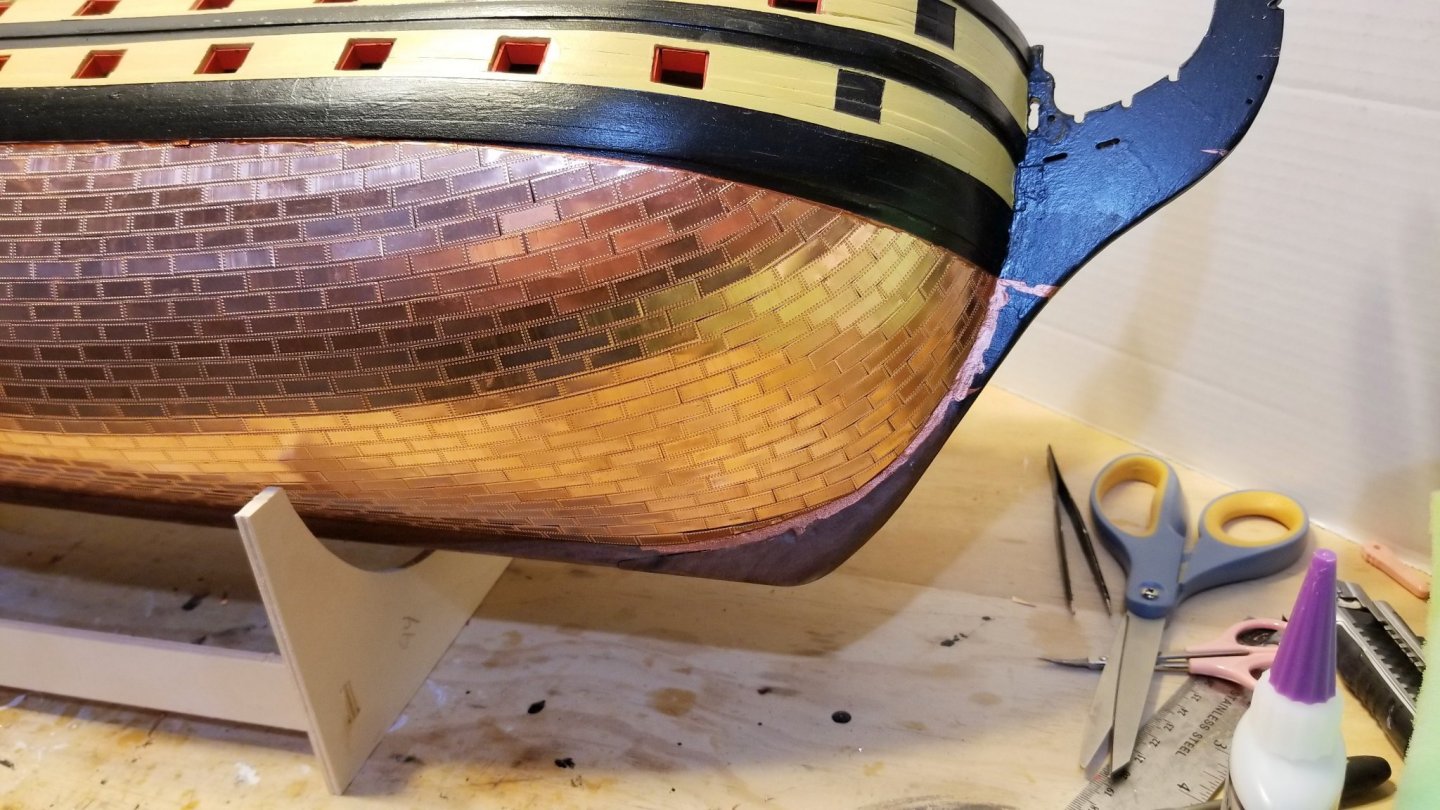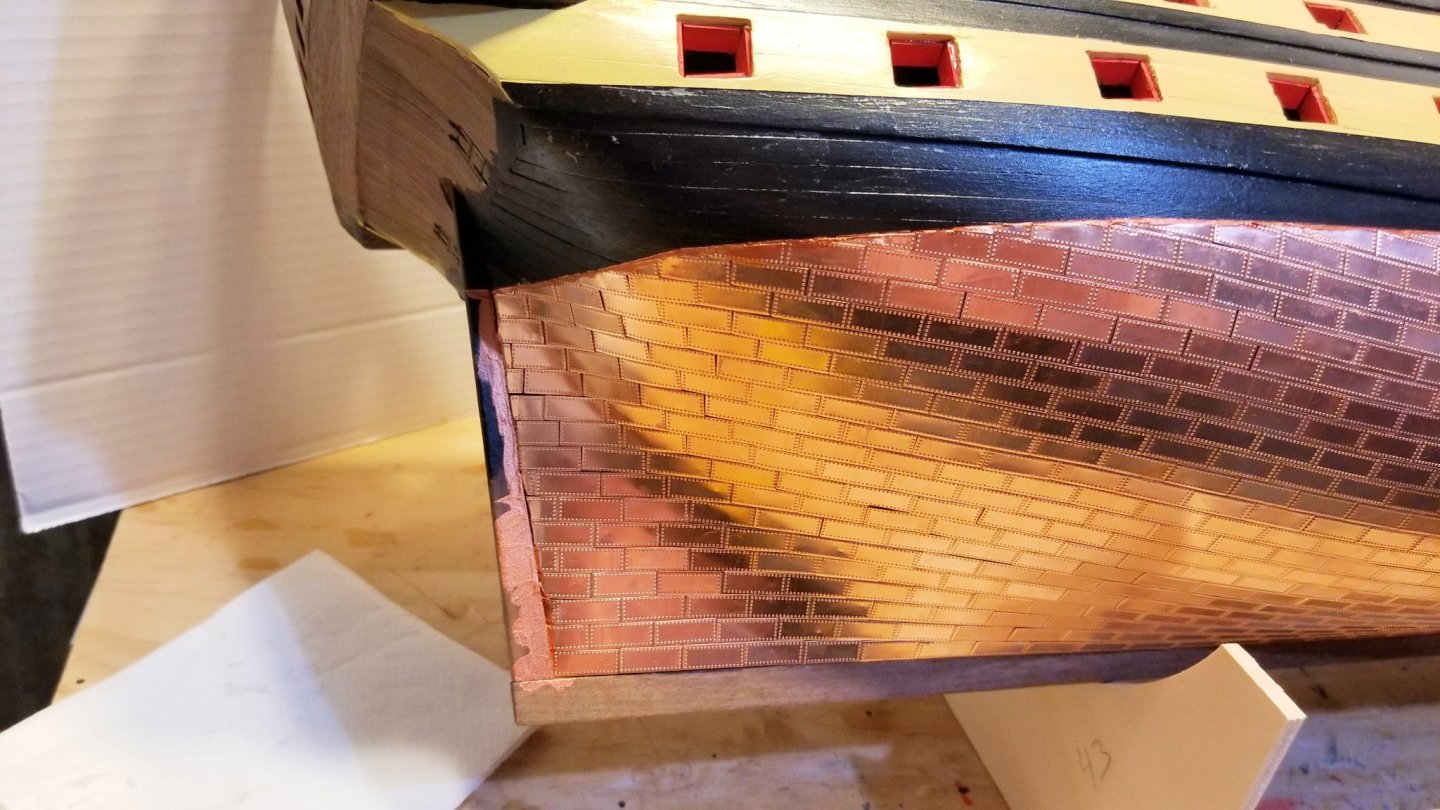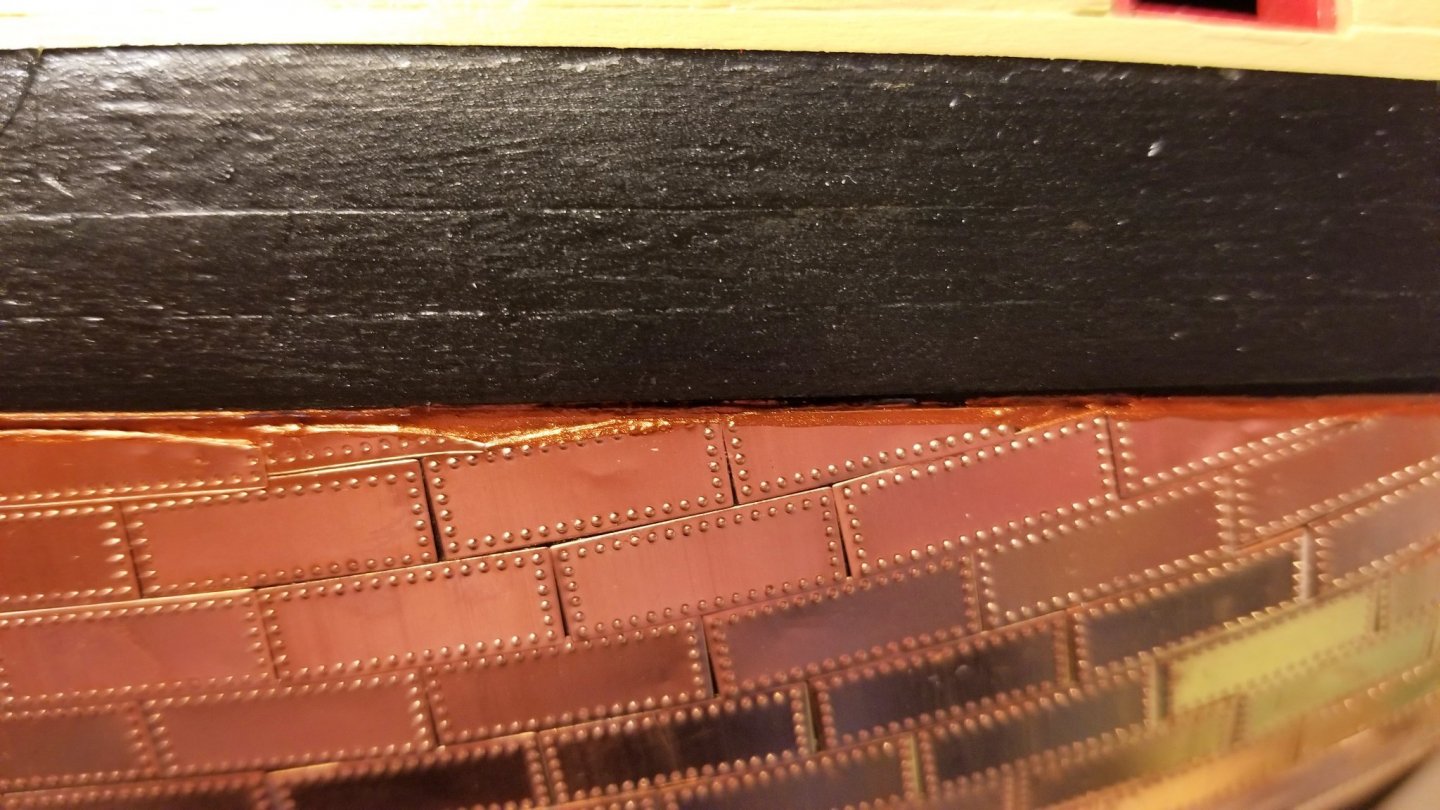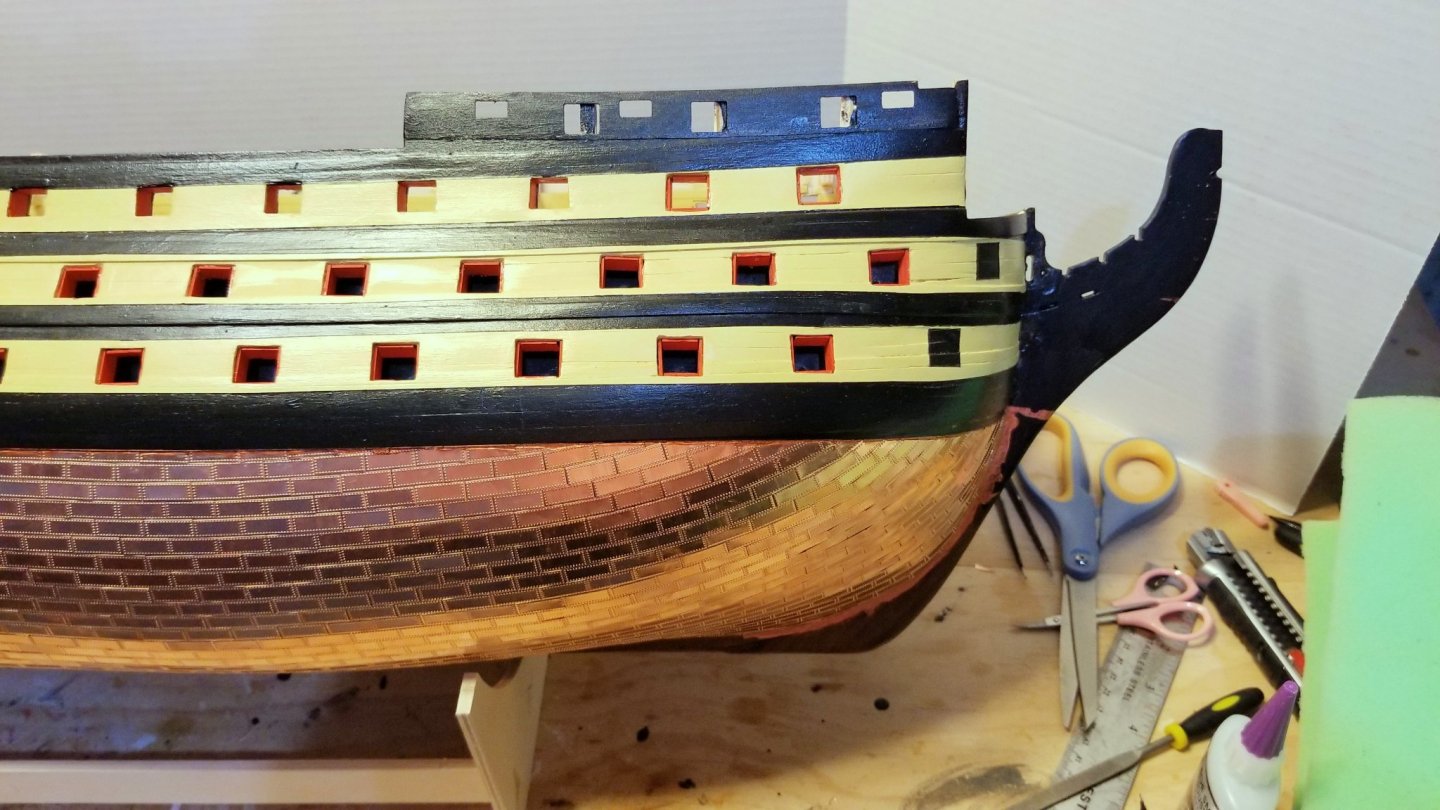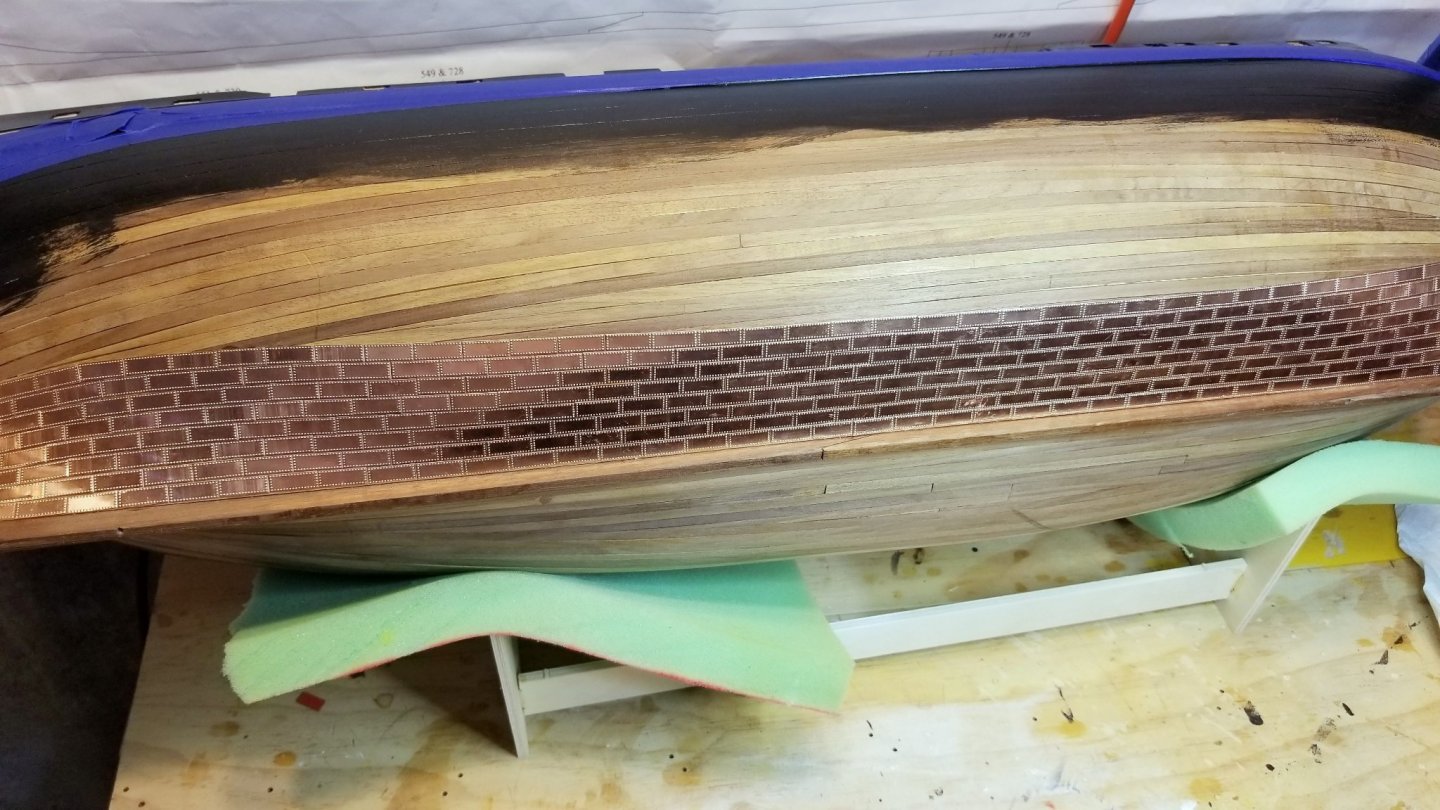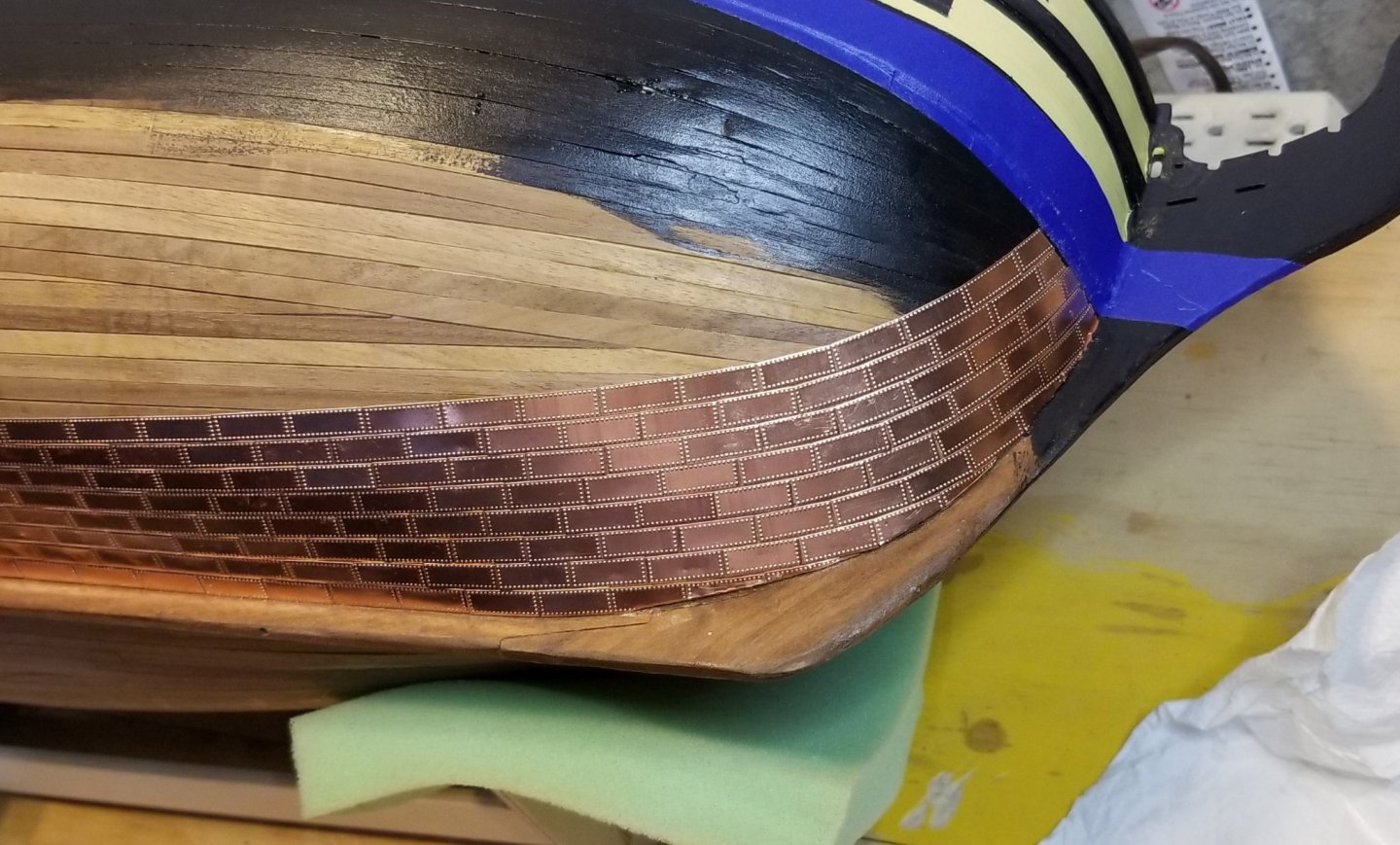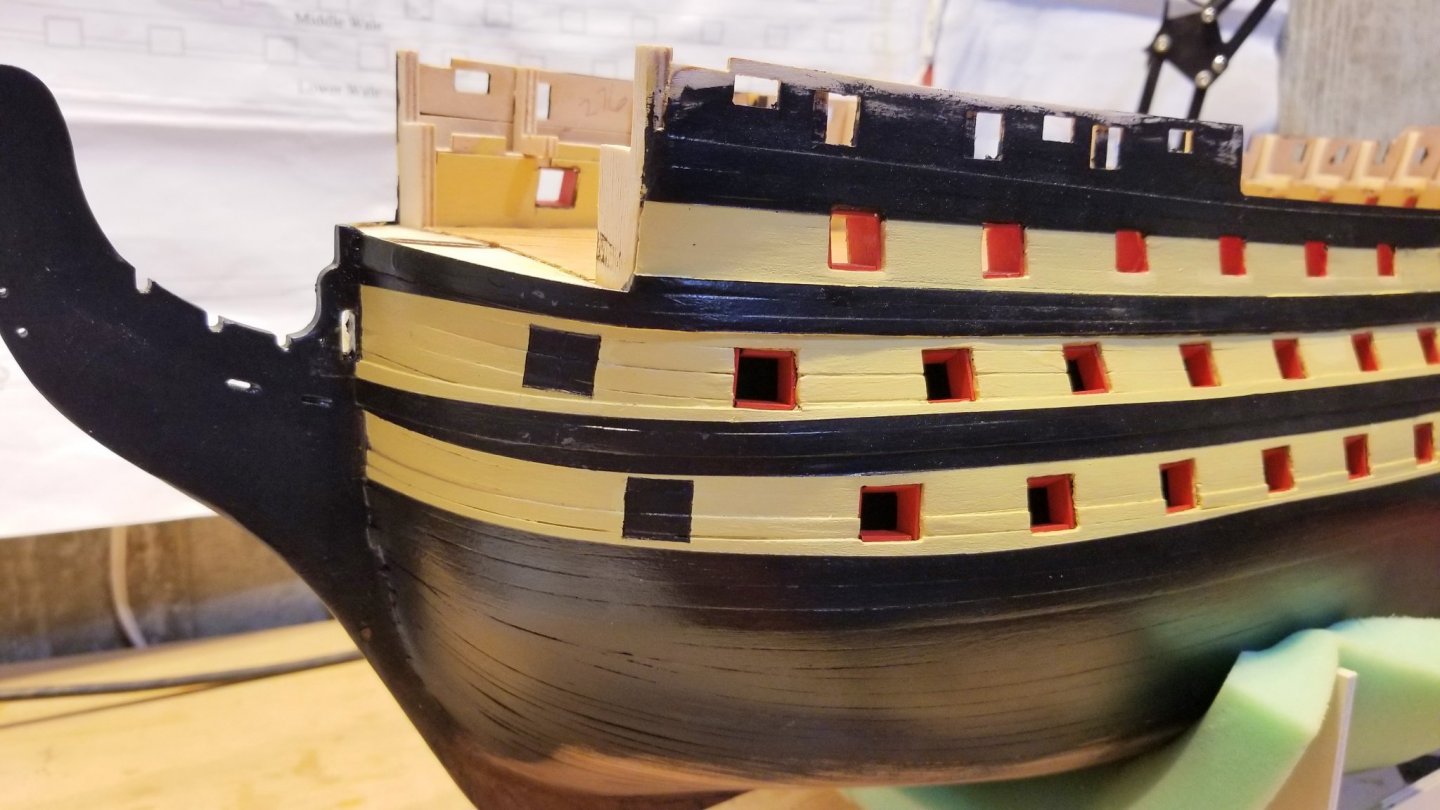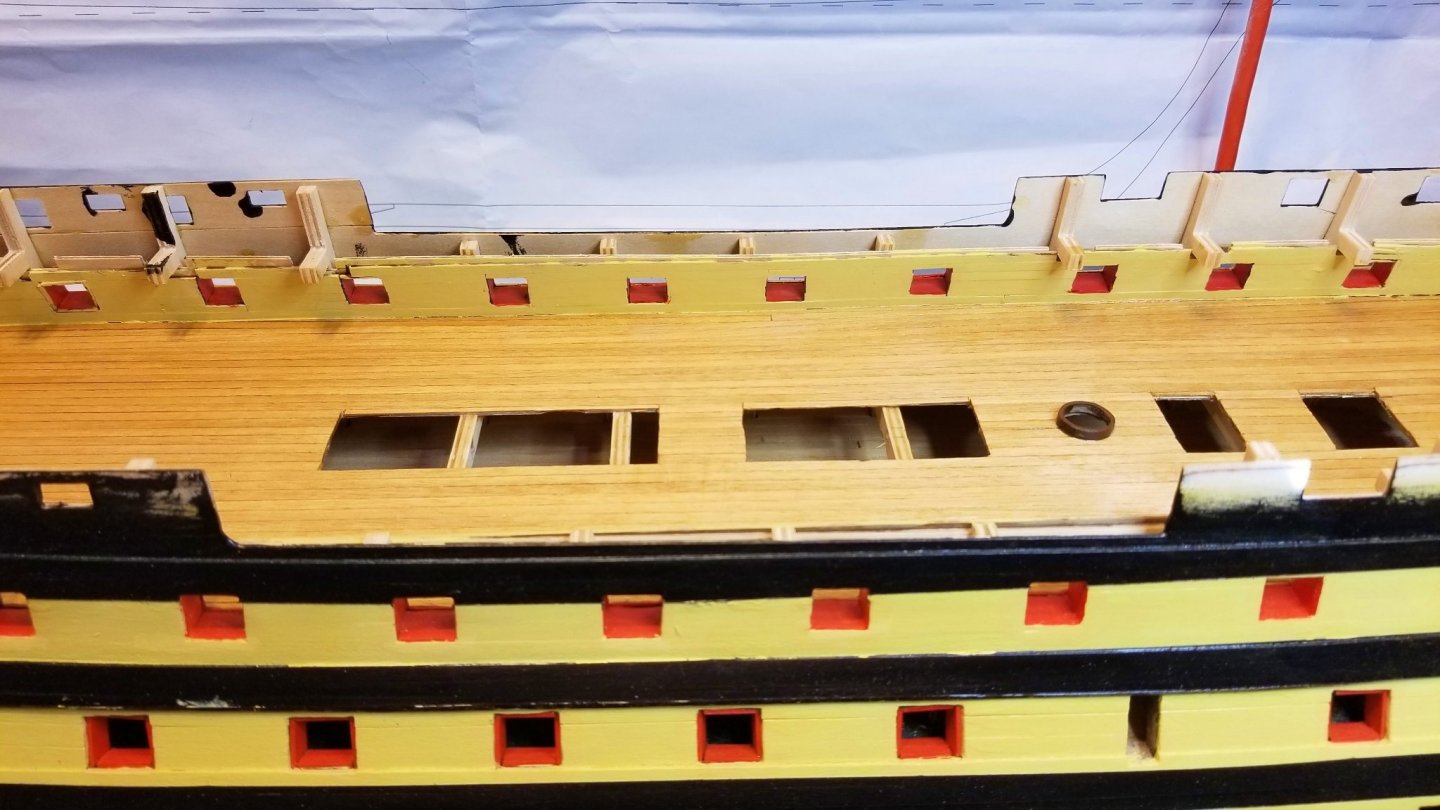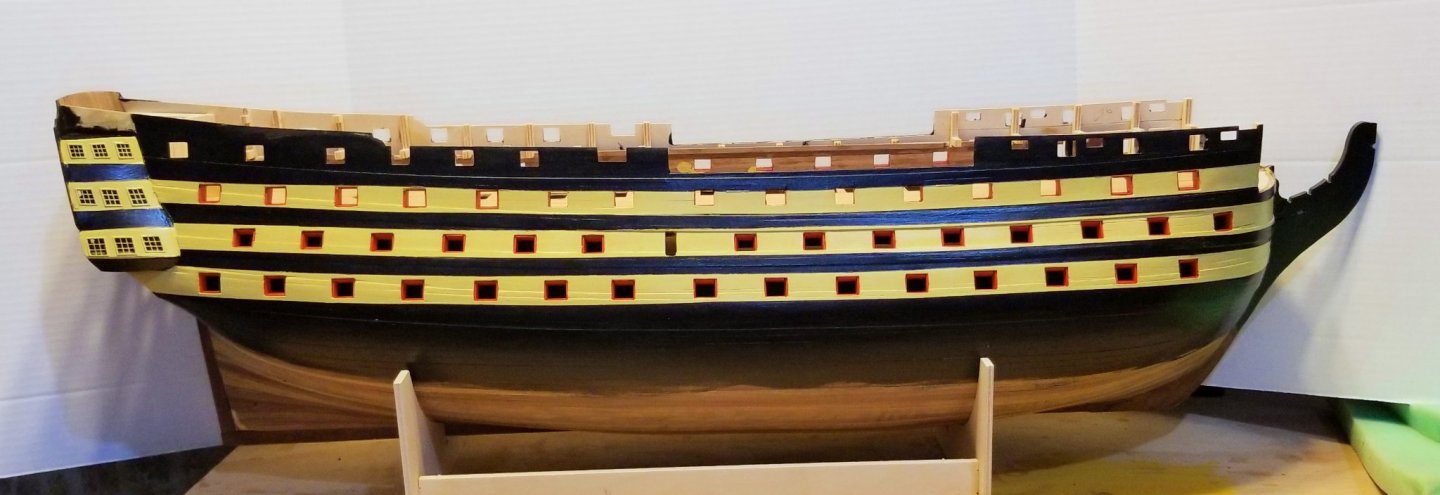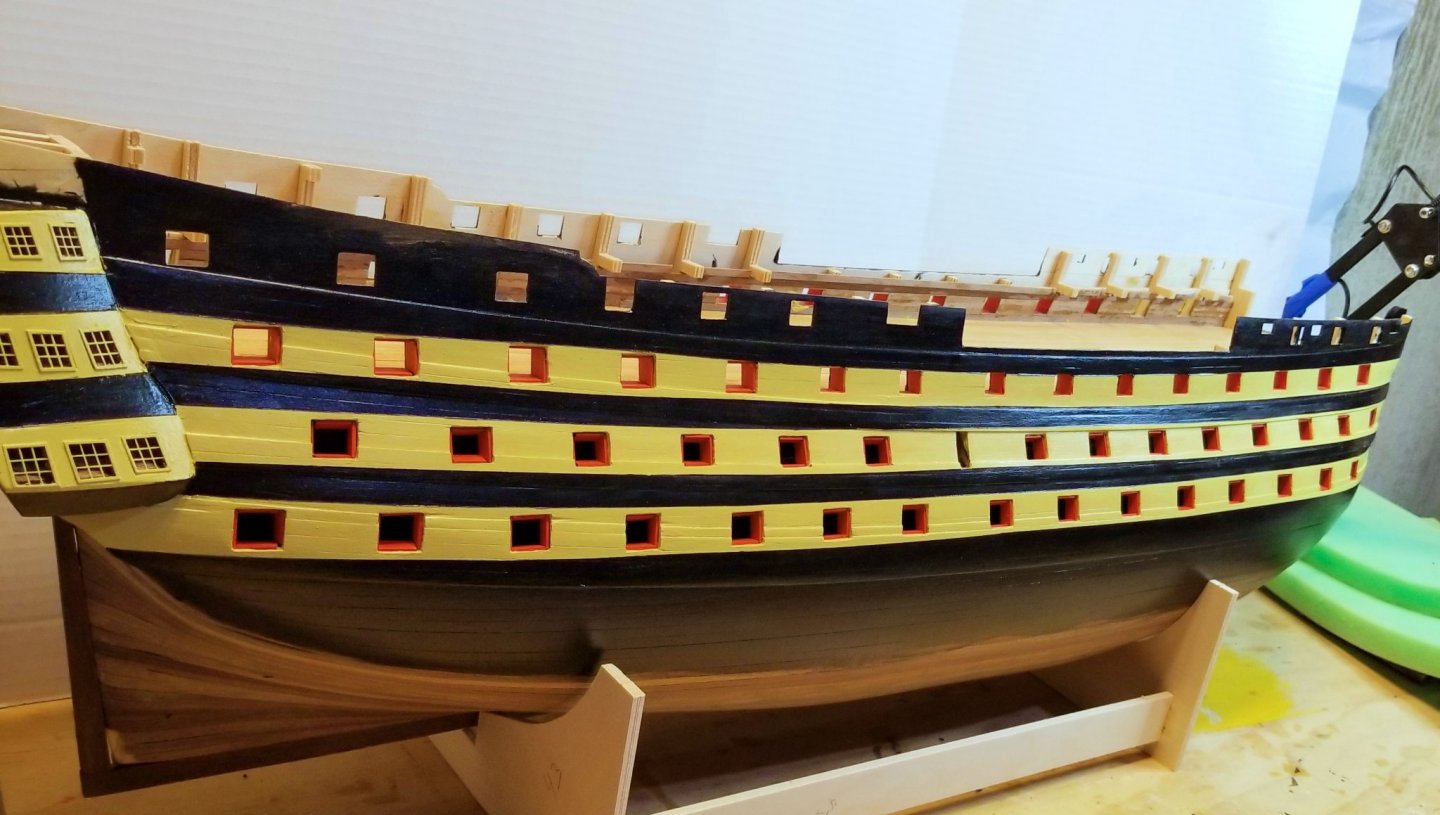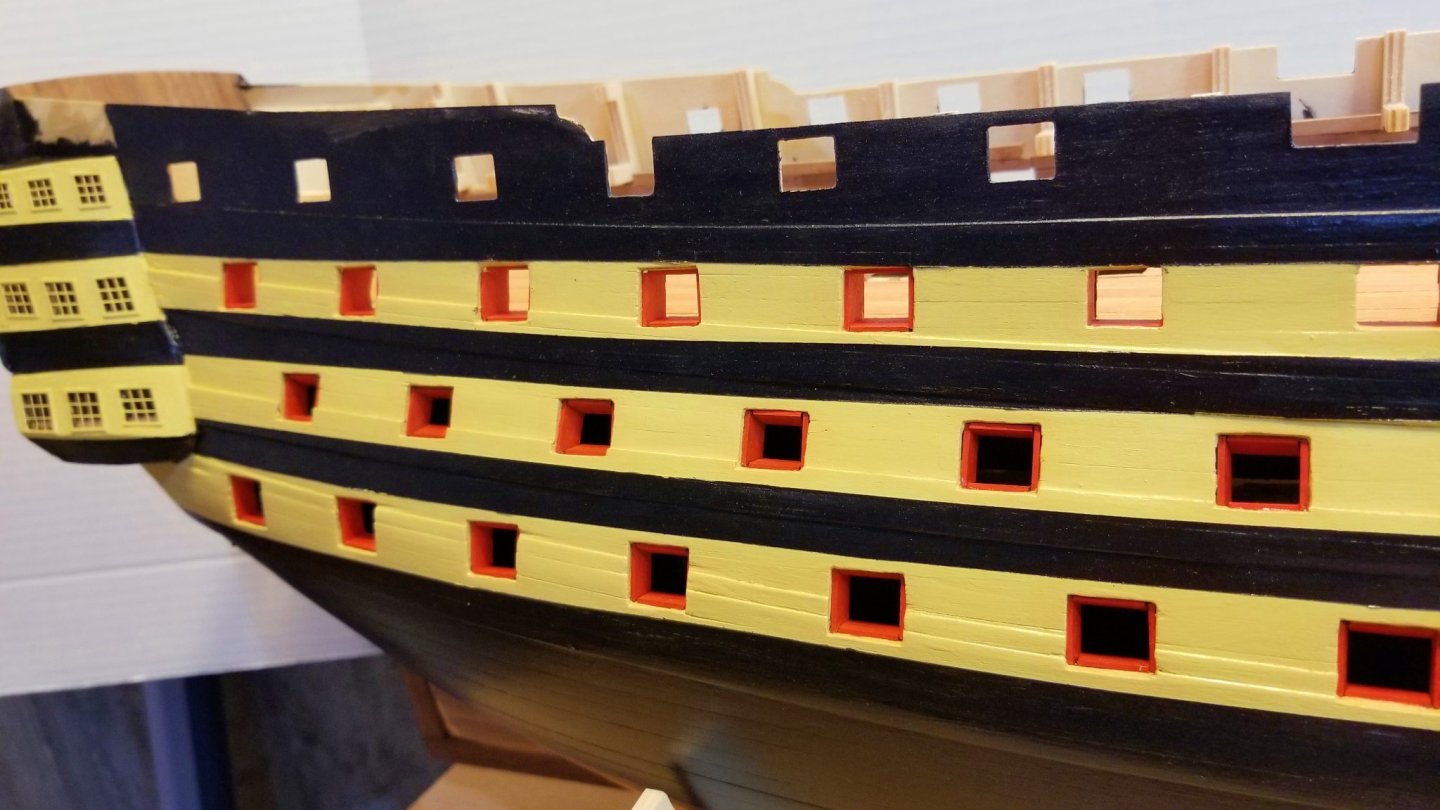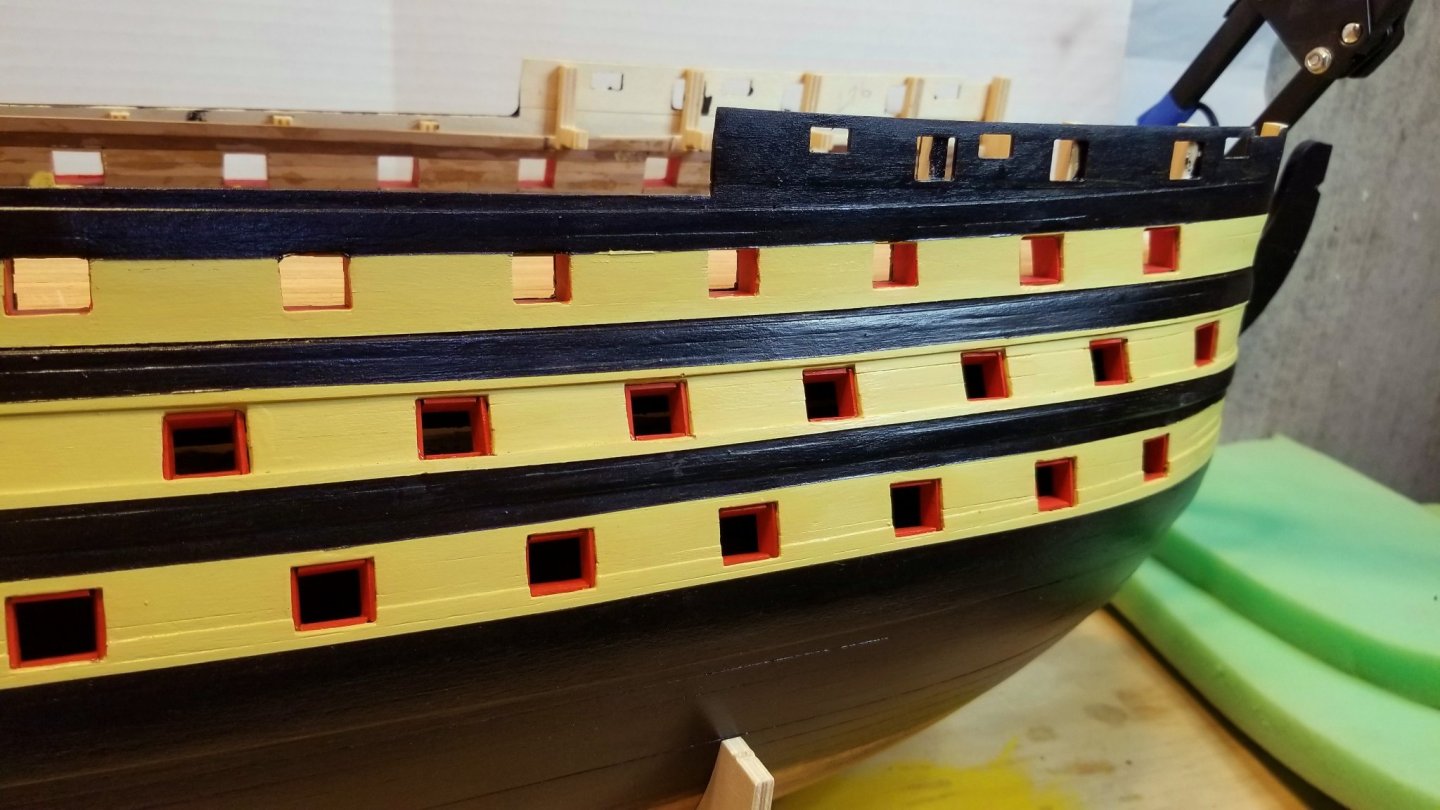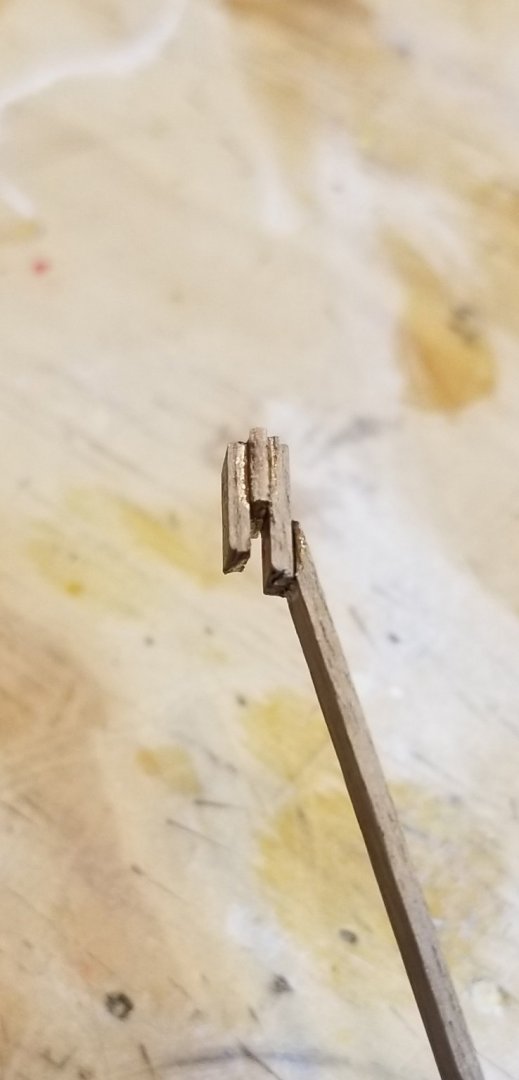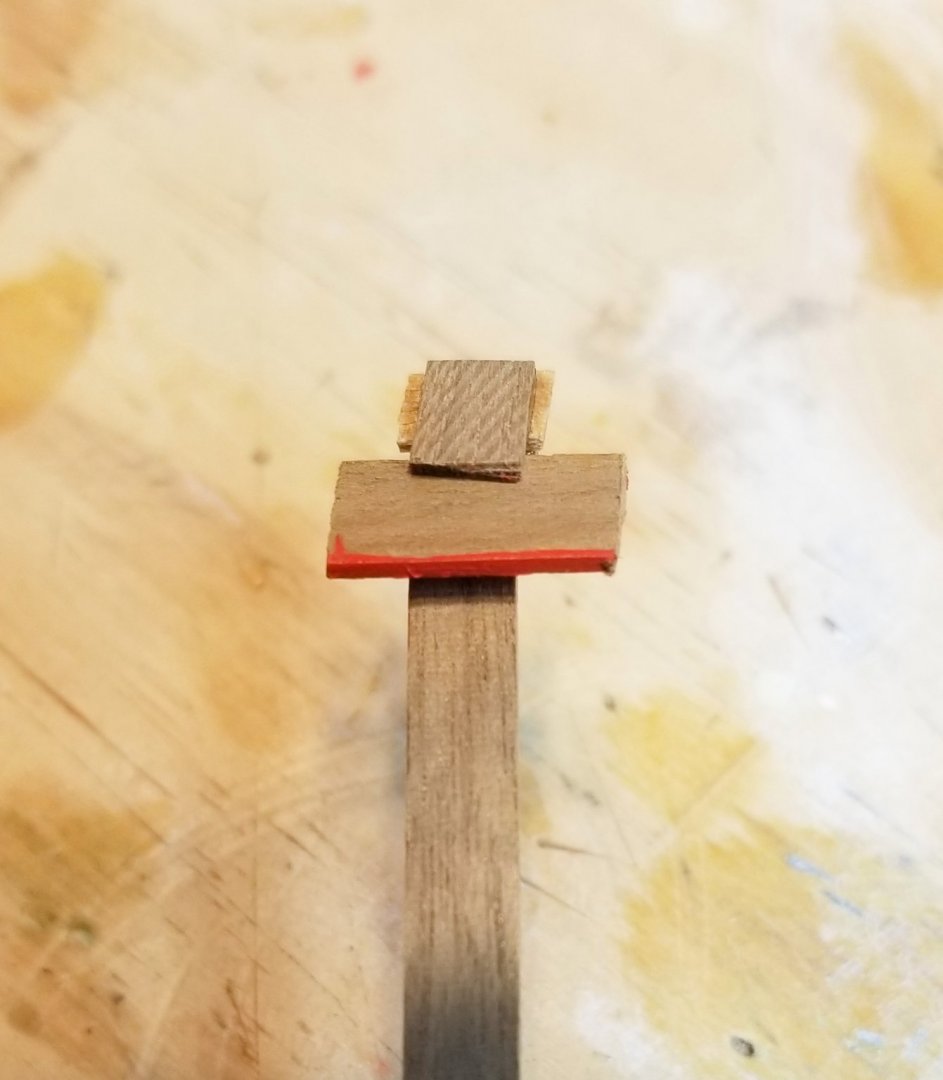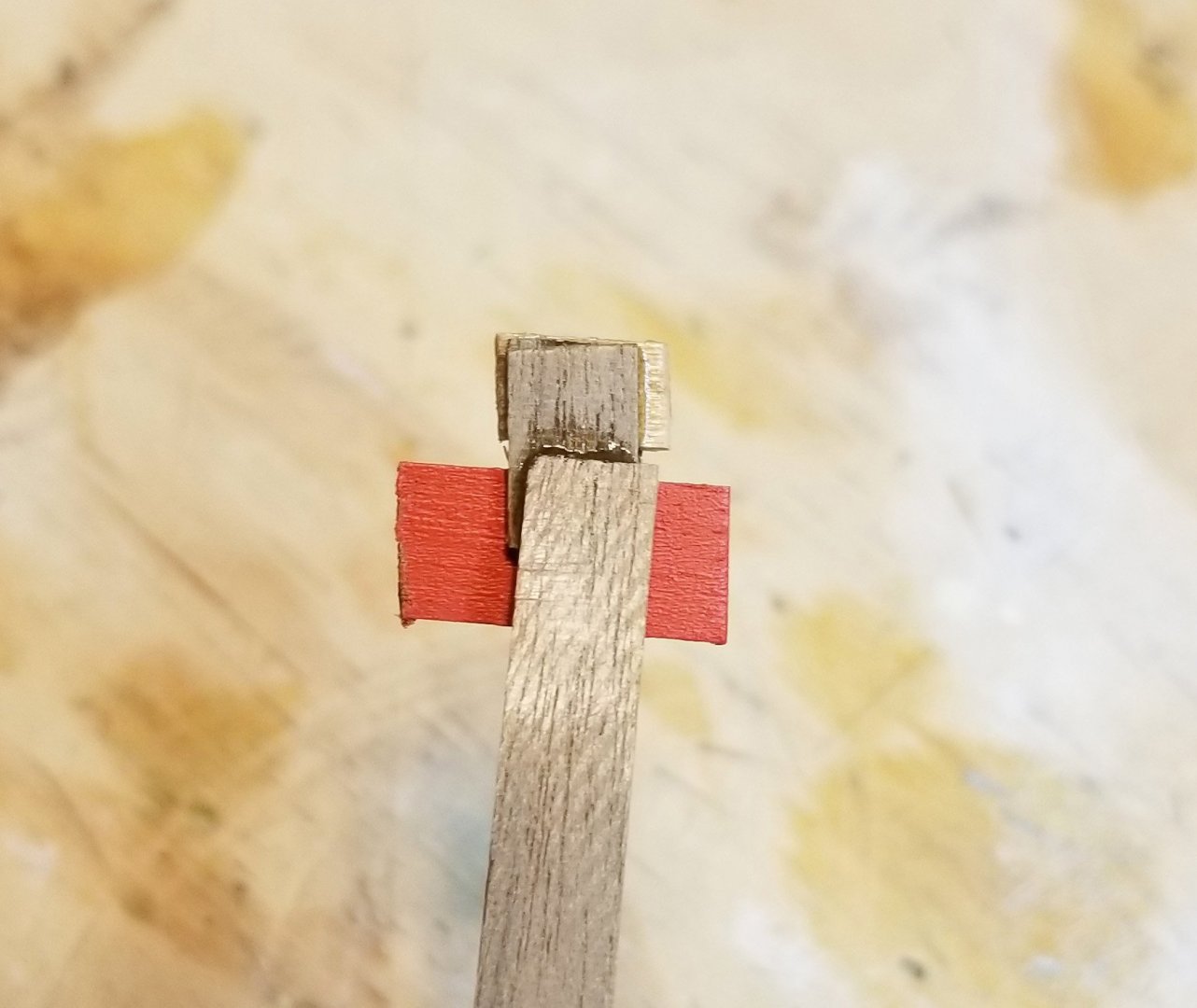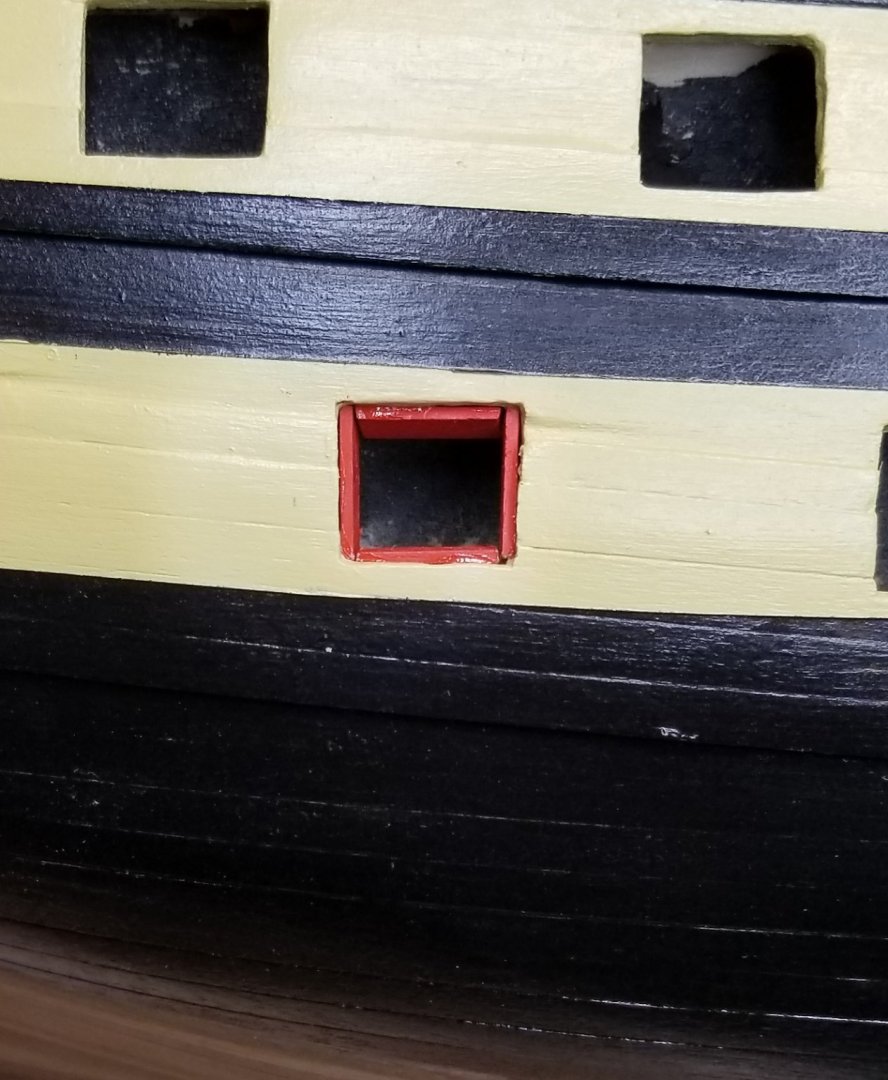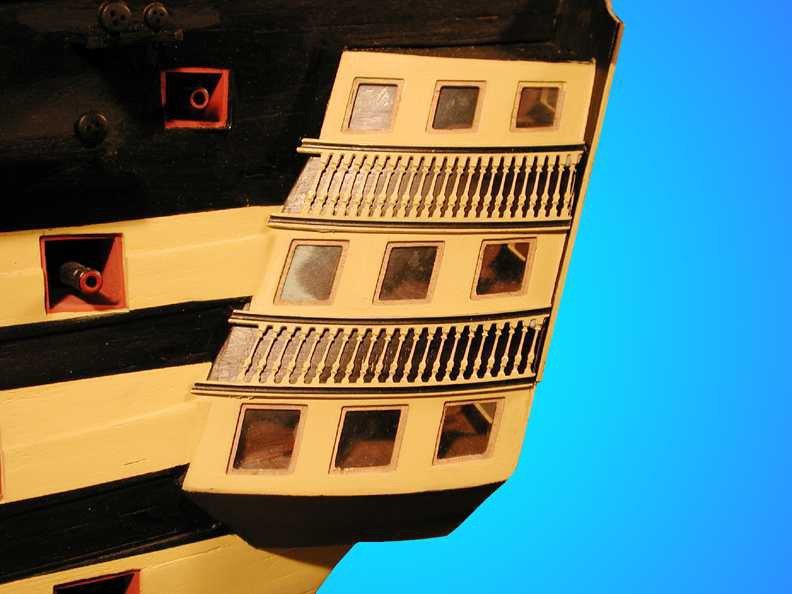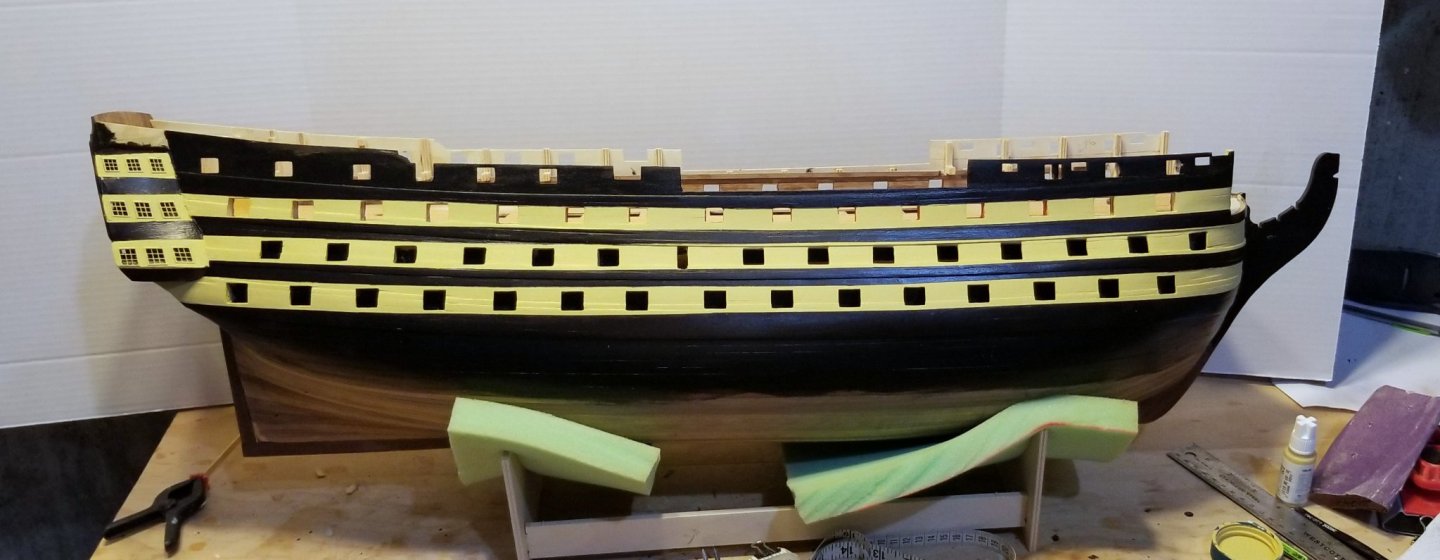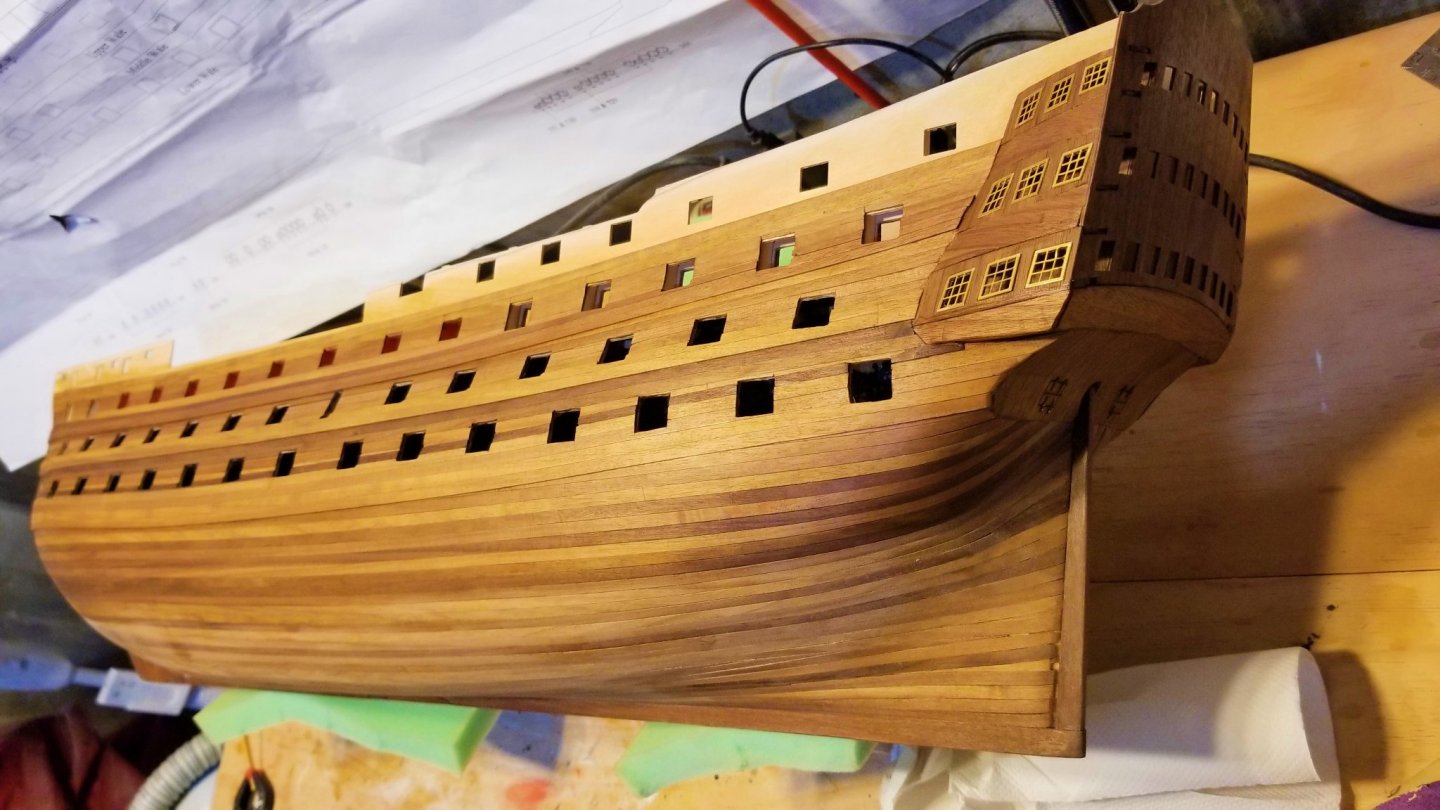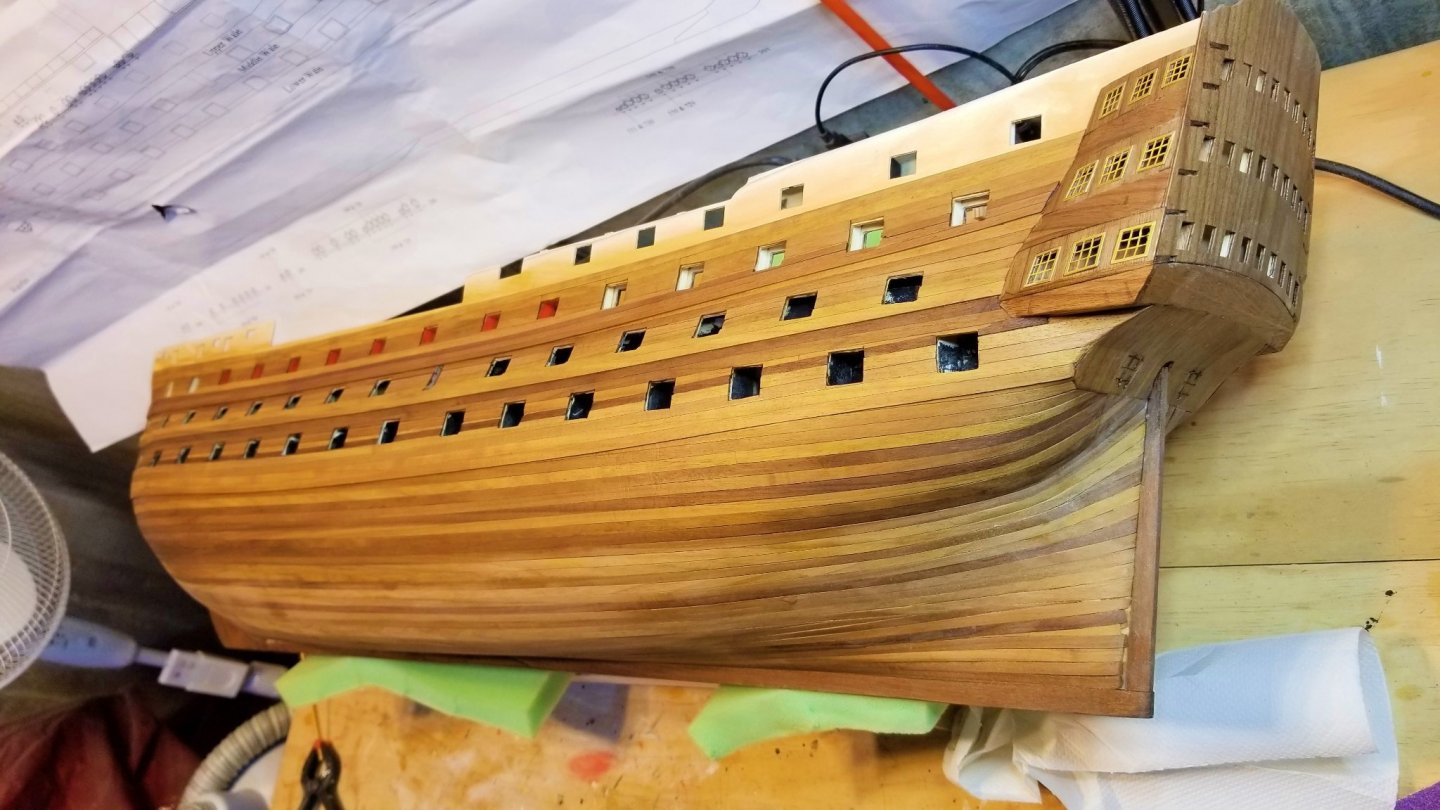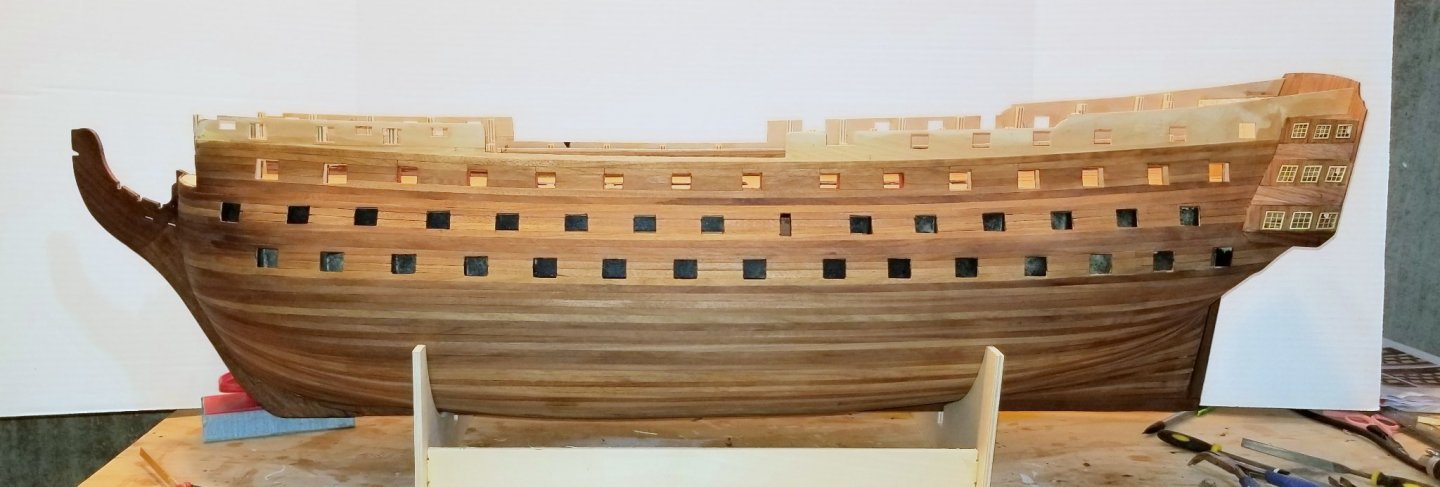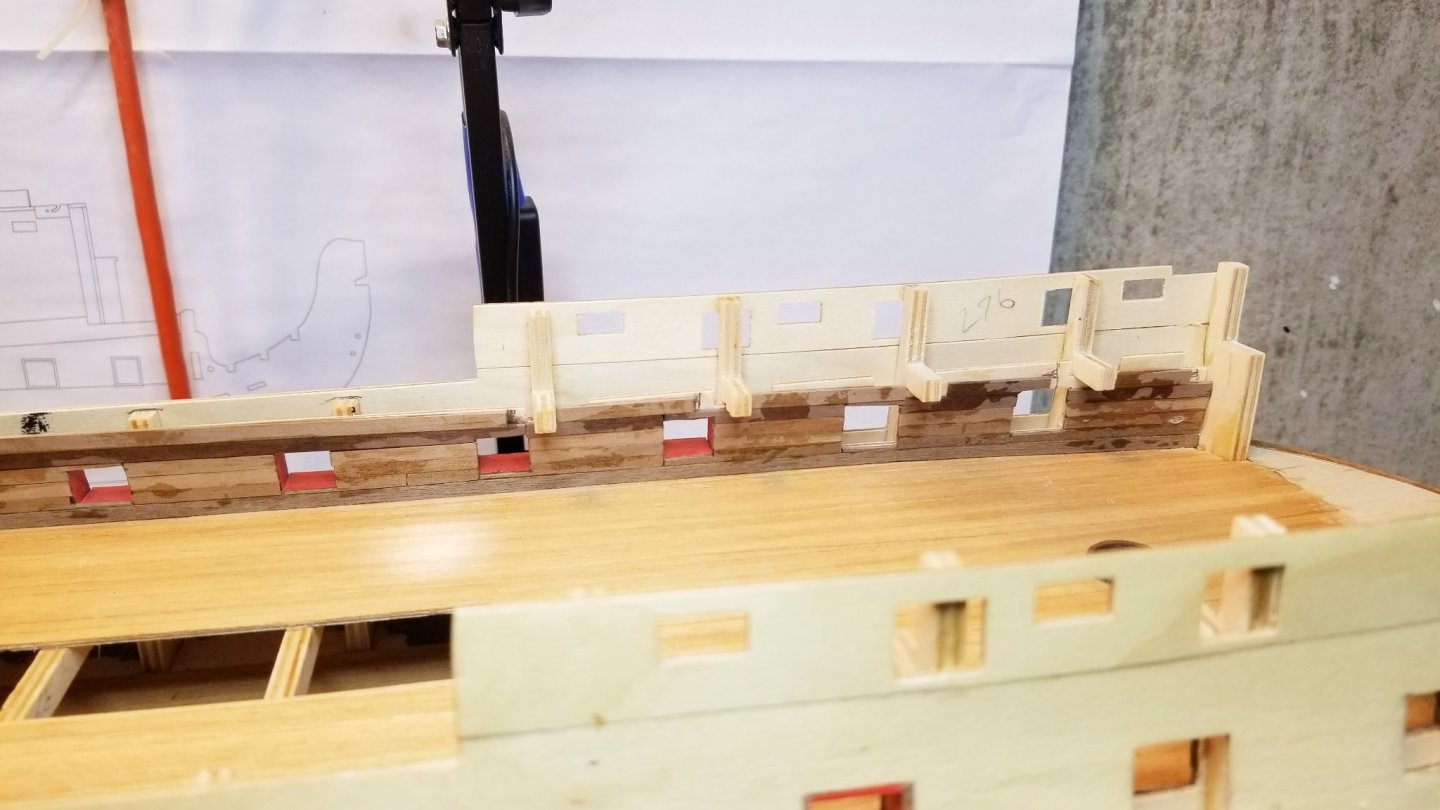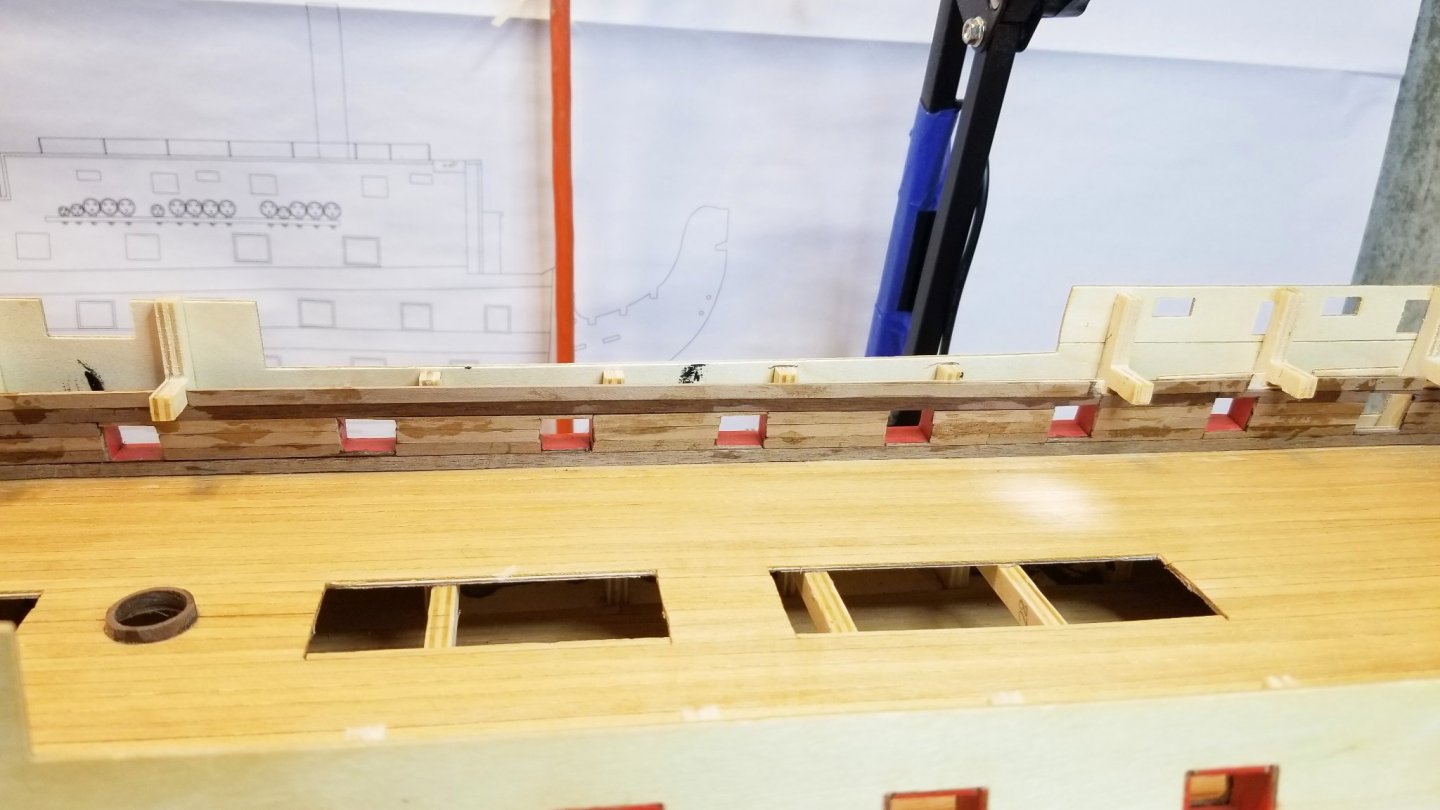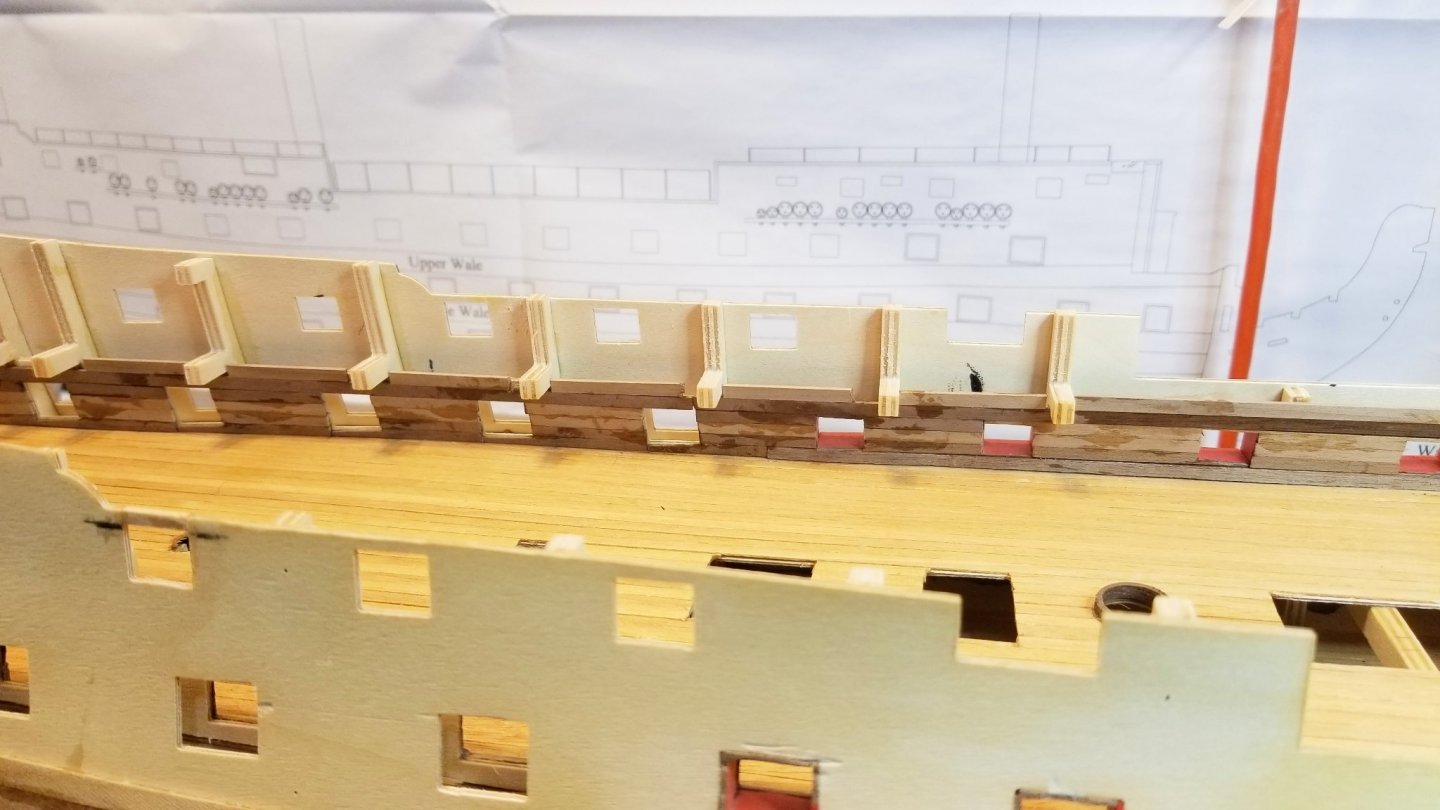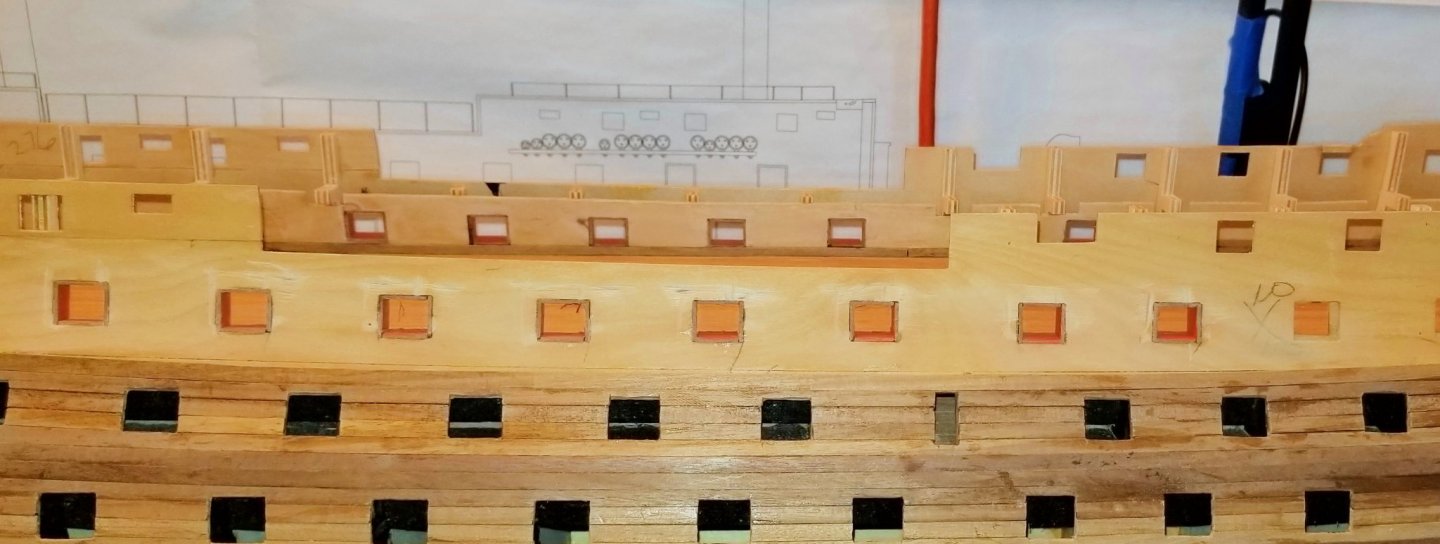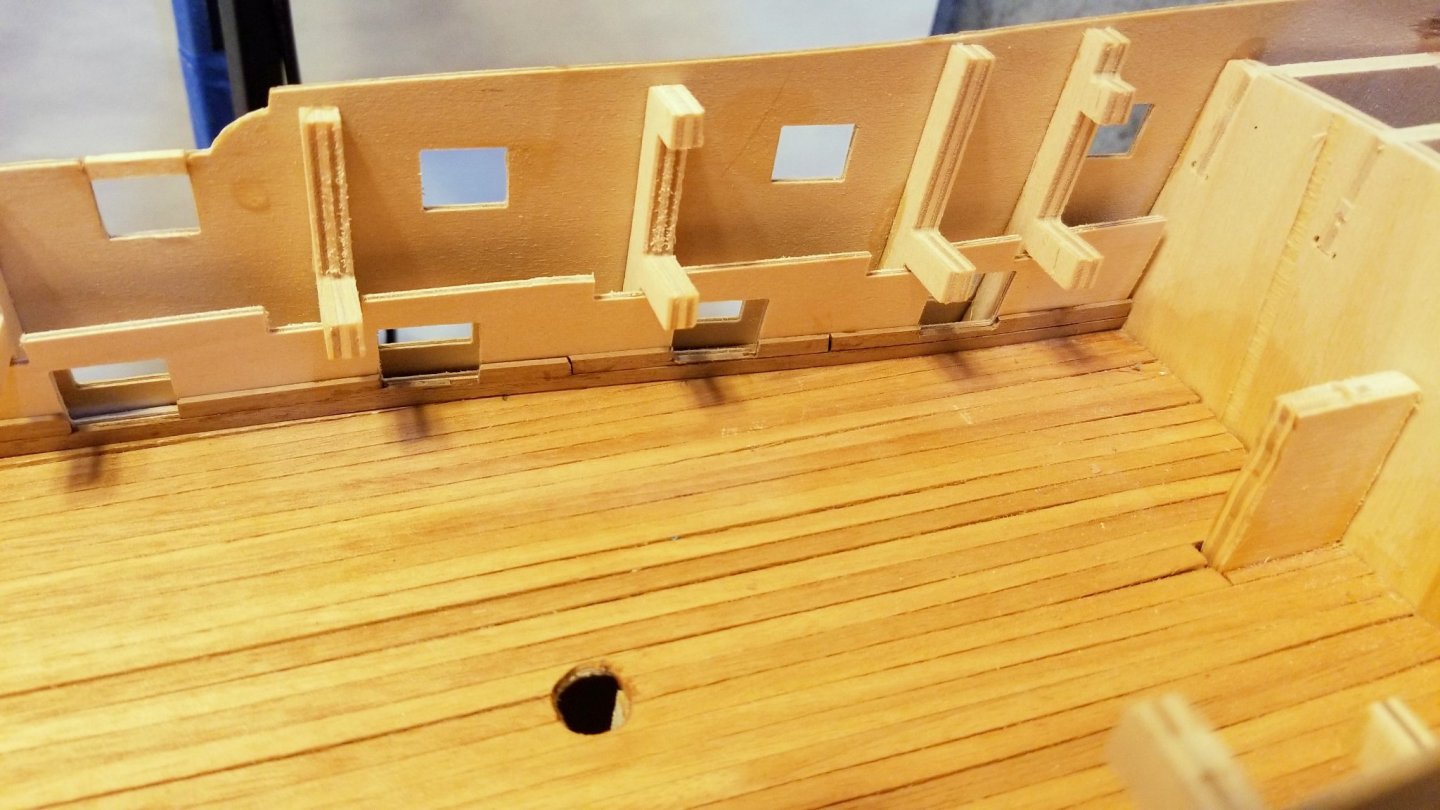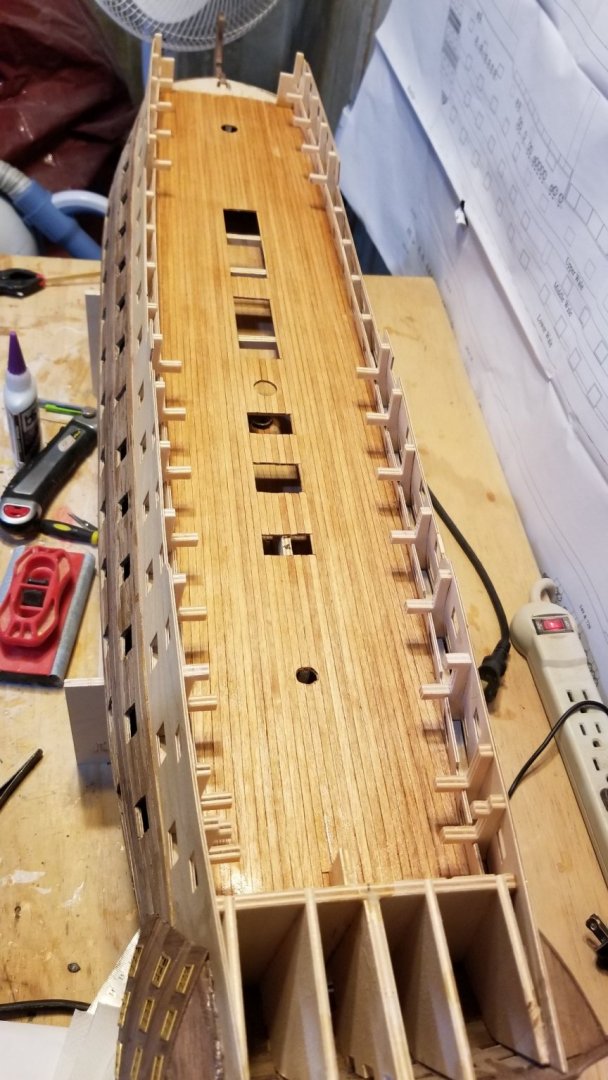-
Posts
1,071 -
Joined
-
Last visited
Content Type
Profiles
Forums
Gallery
Events
Everything posted by drobinson02199
-
Finally finished all of the gun deck cannons. Took about 3 weeks to get through all of them. See picture. I only rigged the ones that are visible from the deck above. Regards, David
- 218 replies
-
- Victory
- Caldercraft
-
(and 1 more)
Tagged with:
-
Cannons completed on one side. A few comments: I only rigged the ones that are visible. Regarding rigging: there are three elements (inhaul, outhaul, breech line), and I only used two -- inhaul and breech. Two reasons: first, adding the outhaul tackle on each side just seemed busy, and I felt that the breech line would add enough interest on the side. Second, I'm lazy. Regards, David
- 218 replies
-
- Victory
- Caldercraft
-
(and 1 more)
Tagged with:
-
I've started building cannons in batches of 6 (to break up the work). This one is from my second batch. I tried to fit the trunion brackets in the first batch, and wasn't able to get them to fit well, and ended up just gluing them down -- but in closeup they look sloppy. So those 6 cannons are mounted in a not-visible part of the ship. For the second batch, I just painted the trunion brackets on, and I think they look pretty good -- and much better than the real ones that I couldn't get to fit. Closeup below so you can see it. Regards, David
- 218 replies
-
- Victory
- Caldercraft
-
(and 1 more)
Tagged with:
-
Here's a building board I made out of plywood scrap from the kit for painting the cannon carriages and cannons. Regards, David
- 218 replies
-
- Victory
- Caldercraft
-
(and 1 more)
Tagged with:
-
Built and installed the upper gun deck hatches and stairs to the lower gun deck. I ran into a kind of sequence issue. You have to install stanchions at the bottom of the stairs, and then put thread into them which leads up to the upper gun deck for later use as part of the hatchway guard rails. So when I went to varnish the whole hatch/stairs assembly, I had those threads in the way. If I had thought of it, I could have varnished the stairs before installing them, but I didn't -- so I rigged a temporary set of crossbeams to hold the threads up while I varnished the stairs and hatches. Those are shown below, along with the finished product. Regards, David
- 218 replies
-
- Victory
- Caldercraft
-
(and 1 more)
Tagged with:
-
Allan: Sorry, it's a trick of the photography. My bumps face outward. It's my second coppered model, and I've always assumed that the bumps are supposed to represent the nail heads. The copper plates are also shaped to glue down more easily that way -- it's more difficult with the bumps facing in, and the edges wouldn't mate cleanly. Interestingly, there have been a few plates that have black paint stripes on the "bumps in" side, which would indicate that that manufacturer intends for them to face out. So no kudos for me on that one.😛 On your second point -- I don't know what you mean by "gun port stops". Are you talking about the lining that I did in red -- or is it something that I will encounter further on in the model? Thanks, and regards, David
- 218 replies
-
- Victory
- Caldercraft
-
(and 1 more)
Tagged with:
-
Coppering of starboard hull is in the previous post. I've now finished coppering the port hull (looks the same). I've also finished coppering the keel, stern post and bow on the starboard side, and pictures of those are below. Regards, David
- 218 replies
-
- Victory
- Caldercraft
-
(and 1 more)
Tagged with:
-
I've finished coppering the starboard side (not yet the rudder frame or bow piece or keel). I gave some thought to whether to start at the keel, as the manual suggests, or start across the waterline to get a straight edge. I knew if I did the latter I would lose the beautiful upsweep at the bow, so I went with starting at the keel and hoped that the suggested technique of using copper paint and masking tape would work. So I masked off the waterline and then coppered up to it, leaving gaps in spots. Finally finished, and applied copper paint at the top, said a prayer and peeled off the tape. I was delighted with the result. A really straight looking waterline. Several pics here of the result that show how good the waterline looks, and also that upsweep at the bow -- and the stern line. I also took a closeup of one of the "gaps" that is filled in by the paint, and then stepped back to viewing distance with that gap in the center, and you don't really see it unless you are looking for it. The copper paint is made by Golden, and it's "Iridescent Copper". Got it on Amazon. Regards, David
- 218 replies
-
- Victory
- Caldercraft
-
(and 1 more)
Tagged with:
-
Started coppering the hull. You can see the curved section running up to blue masking tape, which is marking the waterline. I'm trimming it close, and then plan to use a tip from the manual by applying copper paint into the gaps to get a straight waterline. This is my "bad" side (the side that faces the wall), so we'll see how it comes out when I'm done. Not sure there's much choice to do it differently. Regards, David
- 218 replies
-
- Victory
- Caldercraft
-
(and 1 more)
Tagged with:
-
I've drilled the holes for the dummy barrels -- sort of. In the waist area of the boat, the dummy barrel strips rise behind the second level gunports to a point where there's no way to drill a centered hole -- nothing but air there. I drilled off-center holes anyway, but I think for those I'm going to have to put in a jury-rigged fix to keep the cannon barrels aligned. I'll have to drill a hole in a short piece of first planking, put the dummy barrel in the hole, and then using super glue, place the short planking back in the rear of the gunport such that the hole is centered and the barrel is aligned, but at least one end of the planking glues to the part of the barrel strip that's visible. It should work if I align the barrels for the centered holes first. It's a "down the line" step (mounting the dummy barrels), but that's the solution I"ll try. Regards, David
- 218 replies
-
- Victory
- Caldercraft
-
(and 1 more)
Tagged with:
-
- 218 replies
-
- Victory
- Caldercraft
-
(and 1 more)
Tagged with:
-
Gun deck inside bulkheads painted. The critical area to get right is at the waist -- the quarterdeck will block visibility of most of the rest. Regards, David
- 218 replies
-
- Victory
- Caldercraft
-
(and 1 more)
Tagged with:
-
I've lined the gunports on the starboard side. I really like the look of the 3 colors together. I slightly flared the linings inward on the lower two gunport rows to show off the red just a bit more. Can't do it on the top row as the lining orientation is governed by being attached to templates at front and back. Regards, David
- 218 replies
-
- Victory
- Caldercraft
-
(and 1 more)
Tagged with:
-
I have started lining the gunports. They attach by a very thin edge, with 1mm recessed positioning important, so I needed a way to hold them in place while gluing. I made this jig which holds the side pieces with slight pressure, and allows them to be positioned. One finished gunport positioned -- 80+ to go! Regards, David
- 218 replies
-
- Victory
- Caldercraft
-
(and 1 more)
Tagged with:
-
That "floor" idea is a great one. I already have some miscellaneous wood chips rattling around inside my hull. Regards, David
- 218 replies
-
- Victory
- Caldercraft
-
(and 1 more)
Tagged with:
-
Toni: I took the color scheme from this picture on the Caldercraft Website. There are about 80 Victory pics in different stages of construction. Best regards, David Robinson
- 218 replies
-
- Victory
- Caldercraft
-
(and 1 more)
Tagged with:
-
I have painted one side, and I'm pleased with the result. I'll have more to do right at the top when I finish off the planking, but that's down the line, and it will be all black -- no masking needed. For the "yellowish" stripes, I used a color called beige from AK Paints. I wasn't happy with the yellow ochre paints I found online, and this one seemed to have the shade I was looking for, as it has some yellow in it. I'm going to put a coat of varnish on this to protect the paint job. Regards, David
- 218 replies
-
- Victory
- Caldercraft
-
(and 1 more)
Tagged with:
-
Here are the wales. I've attached two pictures that I worked over in different ways in Photoshop because they are hard to see, which is also why I picked the angle I did. The lower wale is the widest and begins in the lowest gunports. You can see the lower edge below them. The middle wale is below the middle gunports, and the upper wale is above them. Some construction notes: The measurements on the plan sheets differ slightly from the actual measurements produced by the gunport templates. The actual vertical distances are a bit larger. So I had to interpolate a bit. The upper wale is tricky, because the middle of the three boards has to lie 1 mm above the front edge. Took some fitting and taping of dummy planks to get it right. Now I will paint the sides, so that the inner lips of the gunports are painted, and then the red gunport lining strips will create a clean finish. I'll have some final painting to do when the top part of the planking is done after the quarterdeck is mounted. Regards, David
- 218 replies
-
- Victory
- Caldercraft
-
(and 1 more)
Tagged with:
-
I'm doing the wales. Lower wale done on both sides (not yet sanded & varnished). Turning to the middle and top wale, I see in the manual that both are made from three 3.5 x 1 mm strips -- so that's a total of 12 strips needed. I have searched the kit and all the wood strip bundles multiple times, and I can find 8. That's not enough to do both wales on both sides, even if I try to redeploy the leftover wood. Three 3.5 strips is 10.5mm. Two 5 mm strips is 10.0 mm, and I have lots of those. Looking at pictures of the model and where other rigging is involved, it seems safest to use the 5mm strips for the middle wale, which will be 0.5 mm narrower than spec, and then do the top wale with the 3.5 strips. I've had worse workarounds. Regards, David
- 218 replies
-
- Victory
- Caldercraft
-
(and 1 more)
Tagged with:
-
Finished planking up the sides to the point indicated in the manual; then sanded & varnished the hull in preparation for adding the wales. A big varnished walnut hull -- very pretty, and 100% will be covered! 😛 Regards, David
- 218 replies
-
- Victory
- Caldercraft
-
(and 1 more)
Tagged with:
-
Finished planking the gun deck inner bulwarks. What you see is unsanded, so all of the messy glue spots will sand out. I'm going to wait to do that until I have lined the remaining gunports, as bulkhead sanding is required for those. As I mentioned earlier, cutting out the gunports didn't seem practical at these angles, so I cut and fitted each piece. Regards, David
- 218 replies
-
- Victory
- Caldercraft
-
(and 1 more)
Tagged with:
-
Yes, what I mentioned in step 3. I will sand and varnish the second planking to protect it and make painting easier. I'll also sand and varnish the inside bulkhead planking before I paint that. Regards, David
- 218 replies
-
- Victory
- Caldercraft
-
(and 1 more)
Tagged with:
-
I have lined the first set of 8 gunports on each side, as called for in the manual. I pre-painted the wood strip before cutting and mounting it into the gunport template openings. I have also started planking the inner bulkheads. I've decided to cut and fit the planks off the ship, then mount them, because if I cut them once mounted I will damage the red painting of the gunport linings. You can see the "piece-part" approach in the picture, although these gunports are different and will be lined later. The ones I have lined are to the left of what you see. Looking ahead in the manual, I have decided on the following sequence: 1) Finish the interior bulkhead planking. 2) Plank the exterior up to just below the top quarterdeck stern gunports (as called for in the manual). 3) Sand and varnish the exterior walnut hull (even though the very last top planks won't be on yet). 4) Add the wales. 5) Paint the exterior with the striped treatment. Doing this at this point will allow me to paint inside the lips the unlined gunports without being too careful. I'll only have to be careful with the lips of the 16 I've already lined. 6) Then prepaint the wood strip red, including the edge facing outboard, and line the remaining gunports (84), most of which are set back 1mm from what will now be the painted gunport lip. This will give me a clean finish at the gunport lips on the exterior if I don't go nuts lining all 84. 7) The newly lined gundeck gunports (14 of those 84) will need to be sanded flush with the inside planked bulkhead. 😎 Then I'll sand and paint the inside bulkhead. This is later than called for in the manual, but I don't see the point of painting it earlier, then having to redo much of it after sanding those 14 gunports flush. Most likely more than you wanted to know, but I thought the painting sequence stuff might be helpful if there is anyone left who hasn't already built this ship. 😋 Regards, David
- 218 replies
-
- Victory
- Caldercraft
-
(and 1 more)
Tagged with:
-
- 218 replies
-
- Victory
- Caldercraft
-
(and 1 more)
Tagged with:
About us
Modelshipworld - Advancing Ship Modeling through Research
SSL Secured
Your security is important for us so this Website is SSL-Secured
NRG Mailing Address
Nautical Research Guild
237 South Lincoln Street
Westmont IL, 60559-1917
Model Ship World ® and the MSW logo are Registered Trademarks, and belong to the Nautical Research Guild (United States Patent and Trademark Office: No. 6,929,264 & No. 6,929,274, registered Dec. 20, 2022)
Helpful Links
About the NRG
If you enjoy building ship models that are historically accurate as well as beautiful, then The Nautical Research Guild (NRG) is just right for you.
The Guild is a non-profit educational organization whose mission is to “Advance Ship Modeling Through Research”. We provide support to our members in their efforts to raise the quality of their model ships.
The Nautical Research Guild has published our world-renowned quarterly magazine, The Nautical Research Journal, since 1955. The pages of the Journal are full of articles by accomplished ship modelers who show you how they create those exquisite details on their models, and by maritime historians who show you the correct details to build. The Journal is available in both print and digital editions. Go to the NRG web site (www.thenrg.org) to download a complimentary digital copy of the Journal. The NRG also publishes plan sets, books and compilations of back issues of the Journal and the former Ships in Scale and Model Ship Builder magazines.




